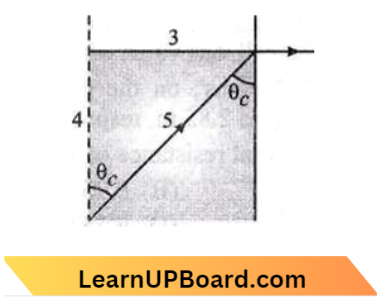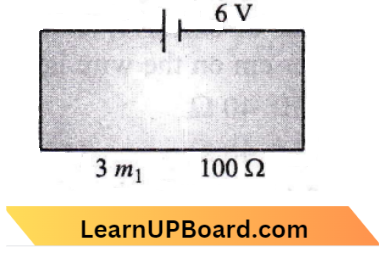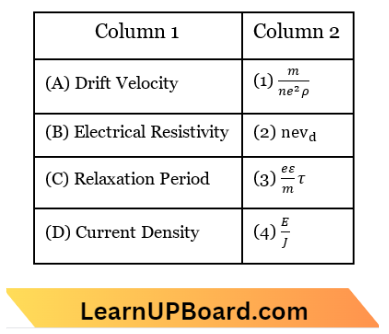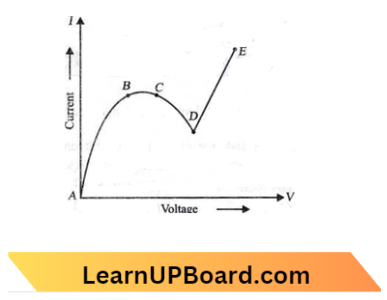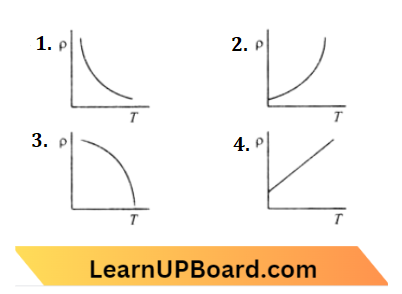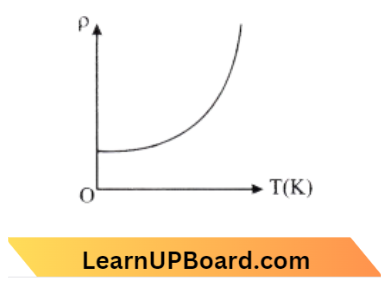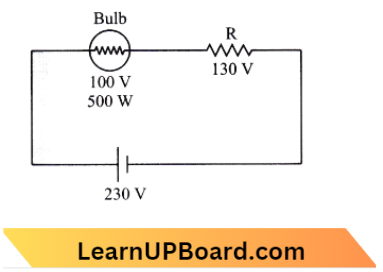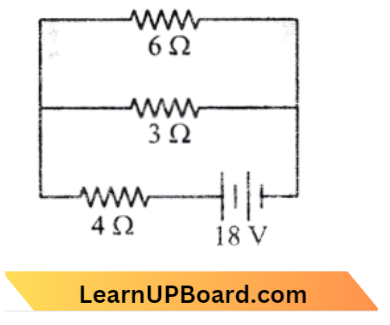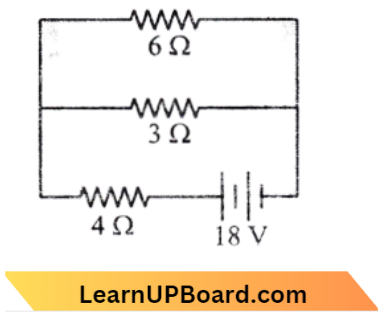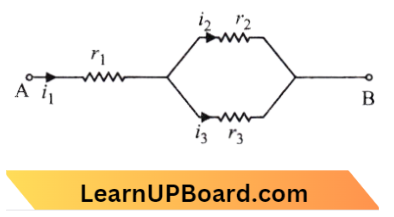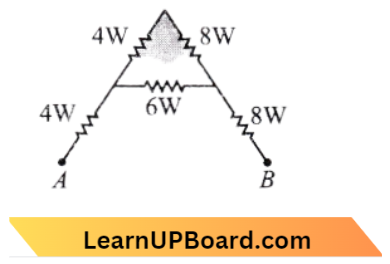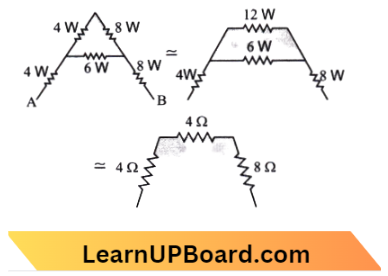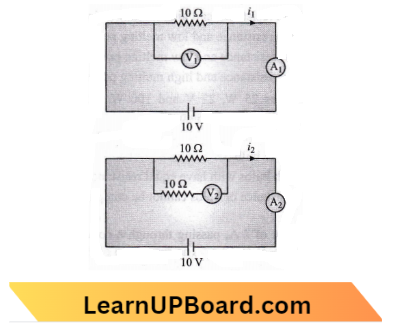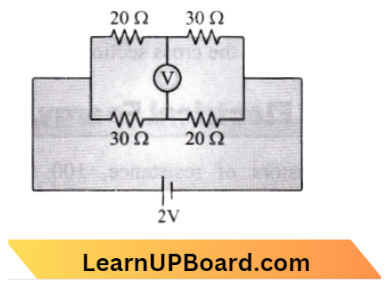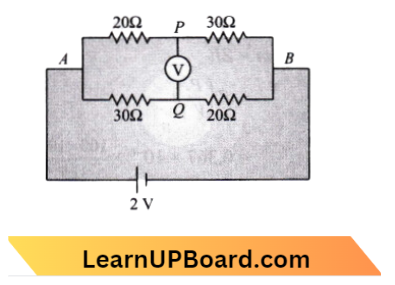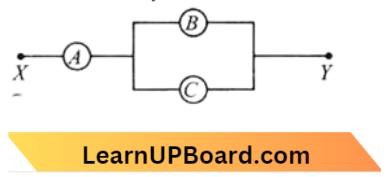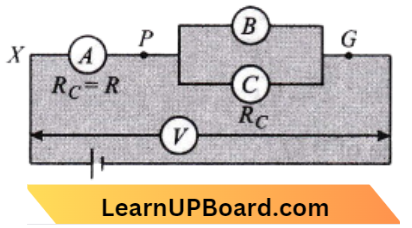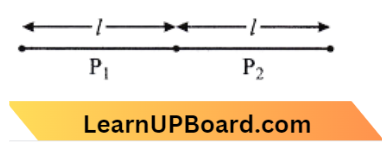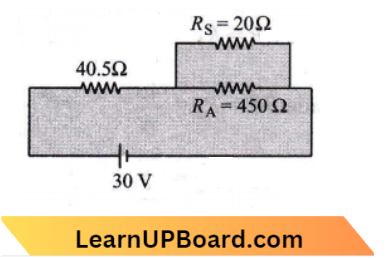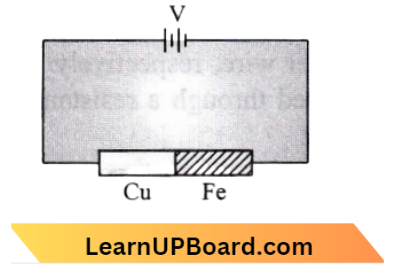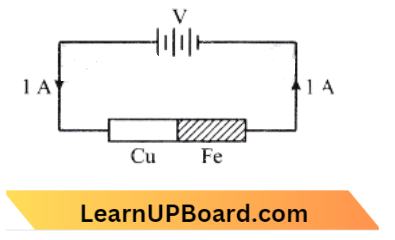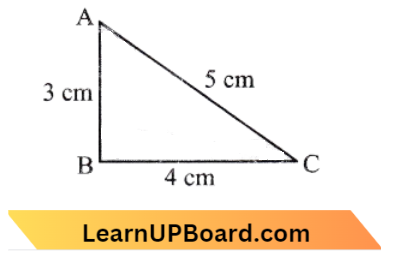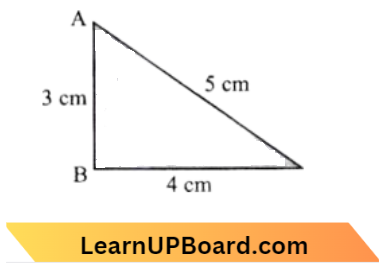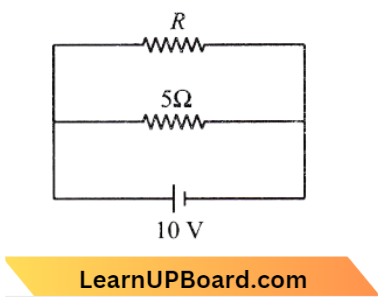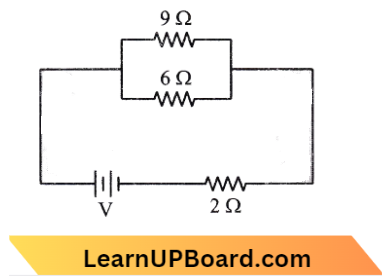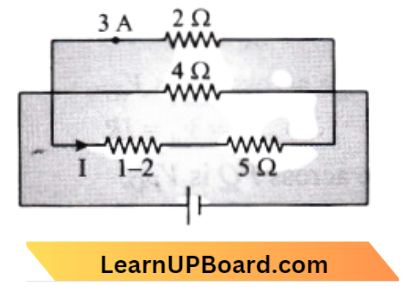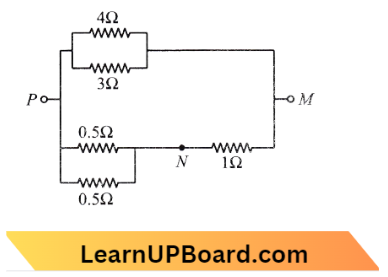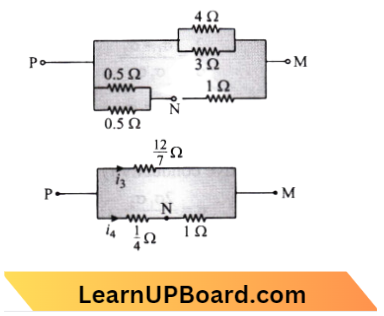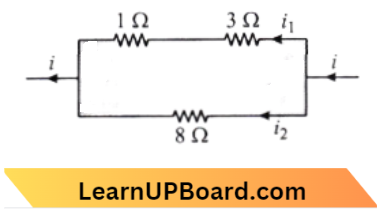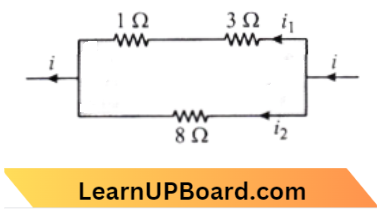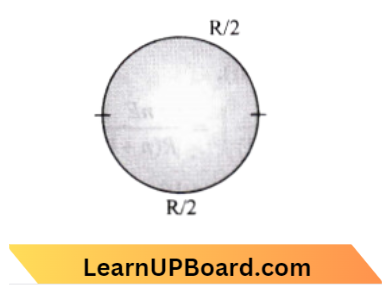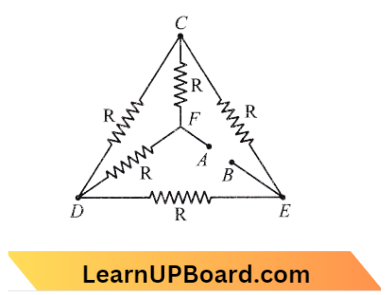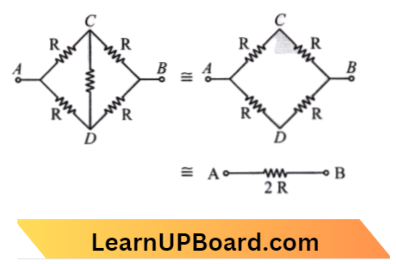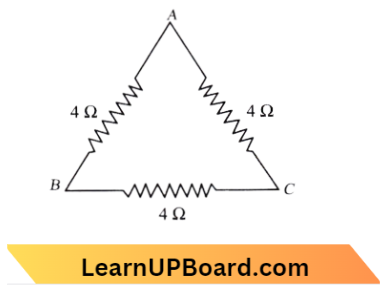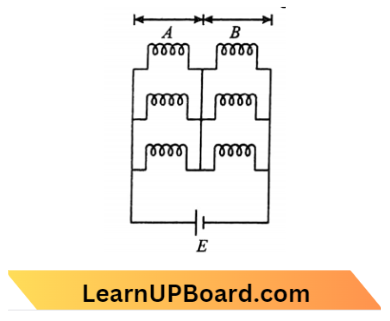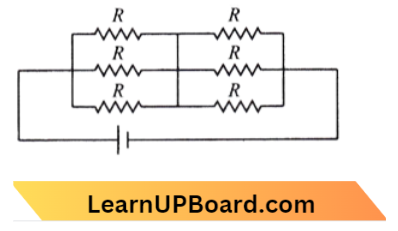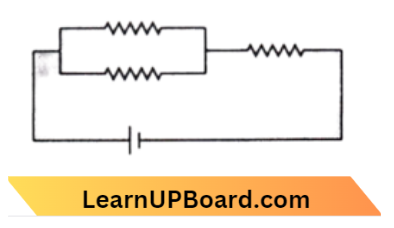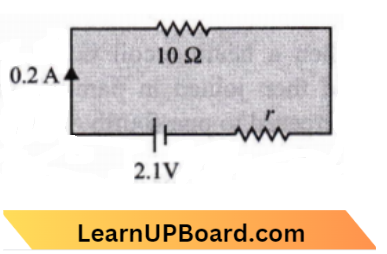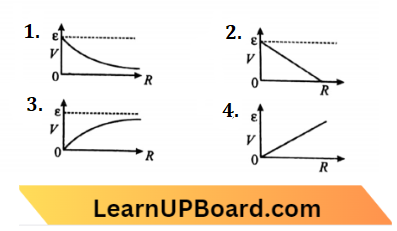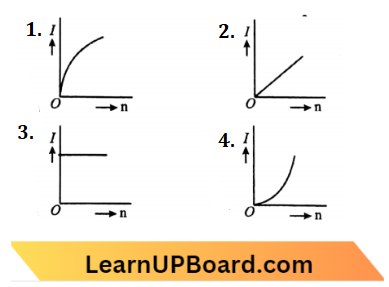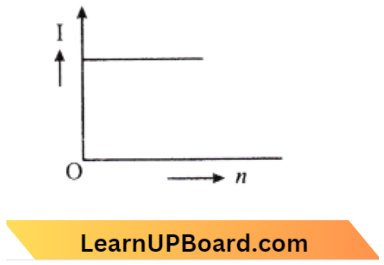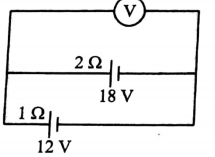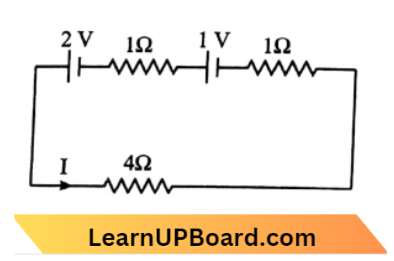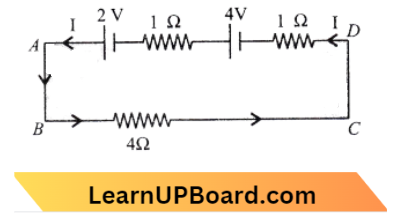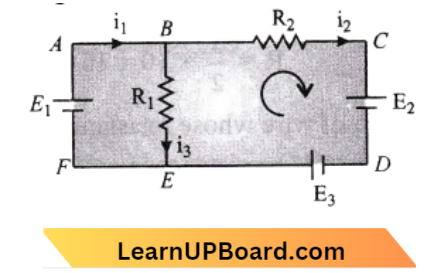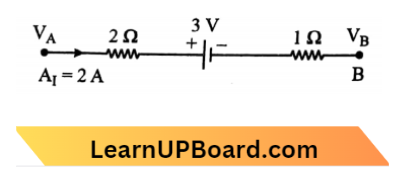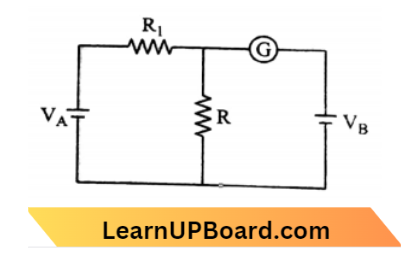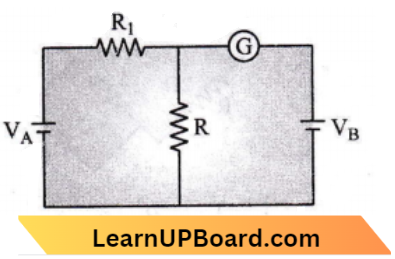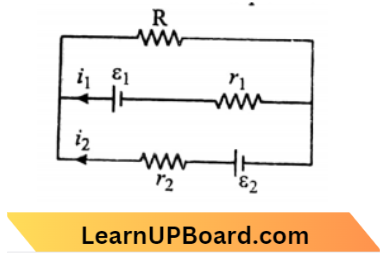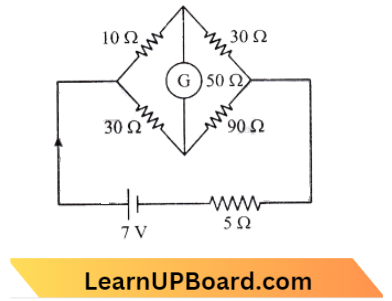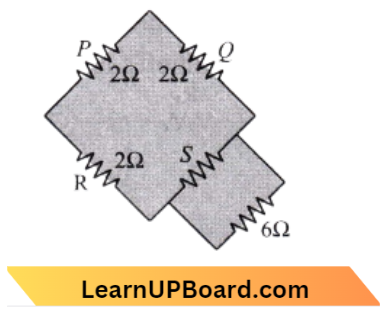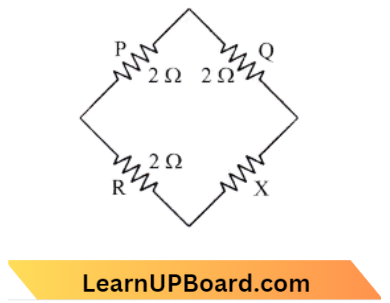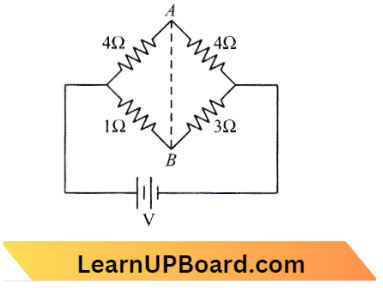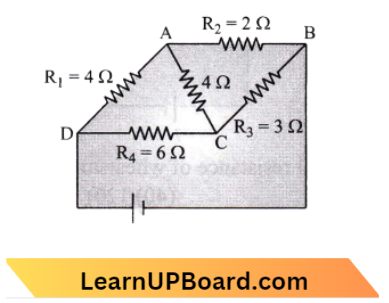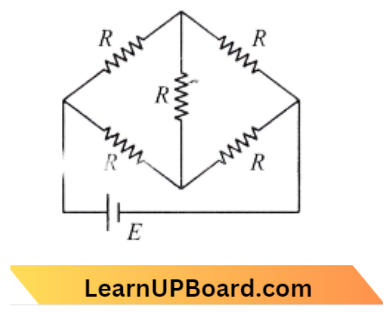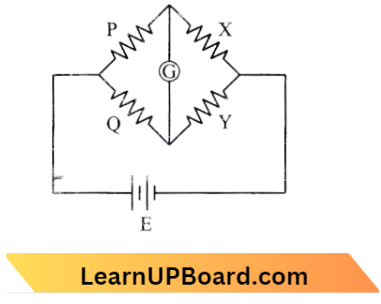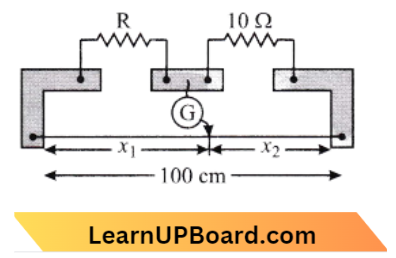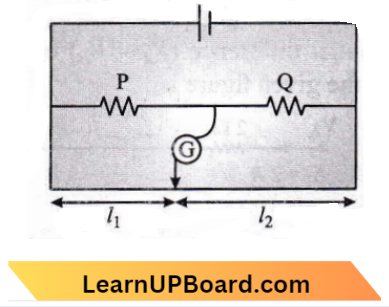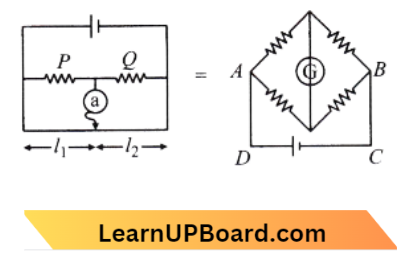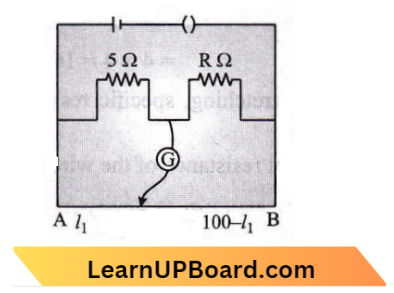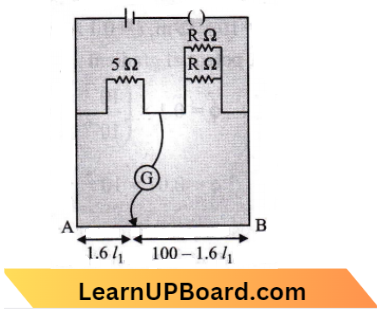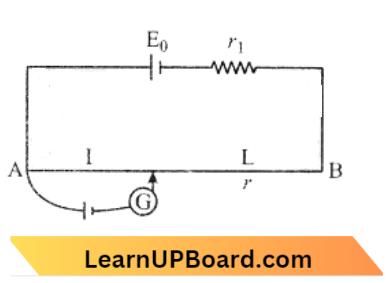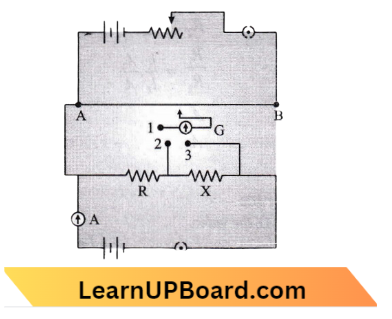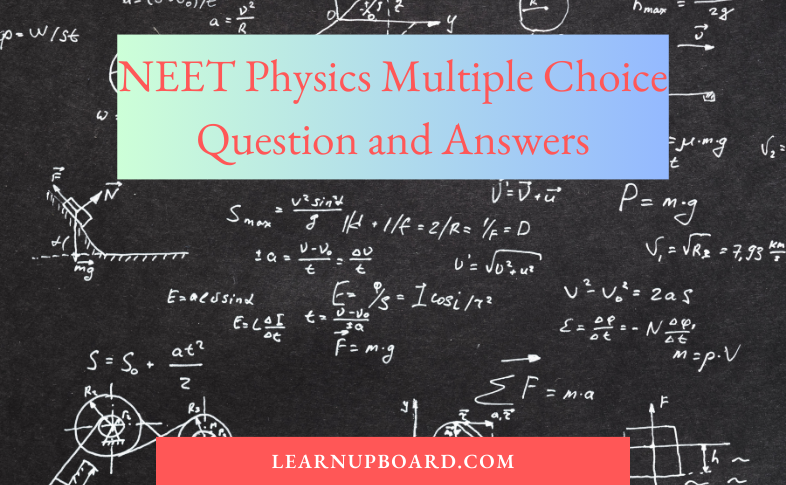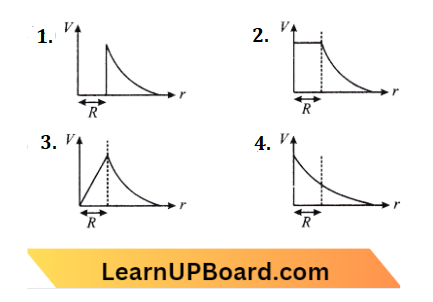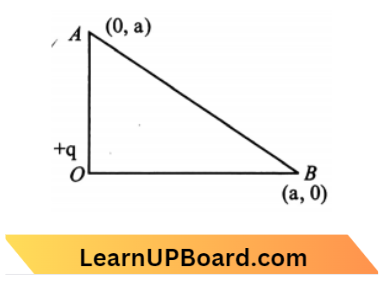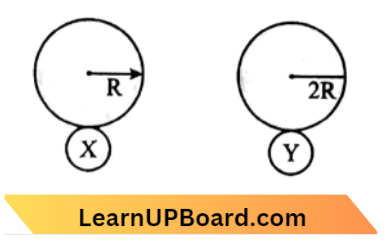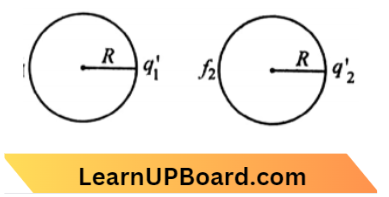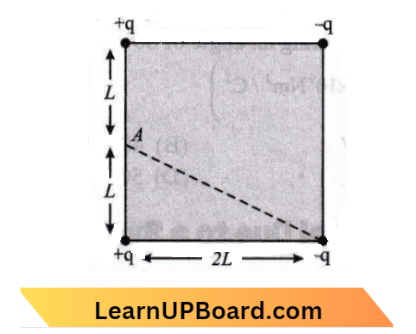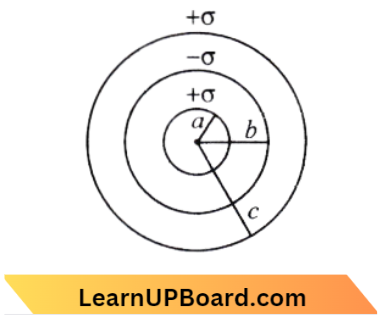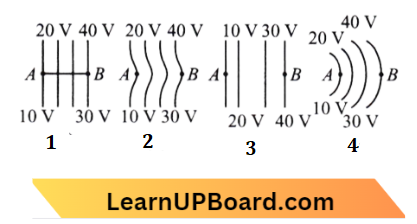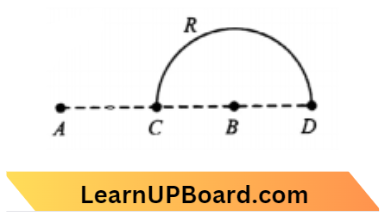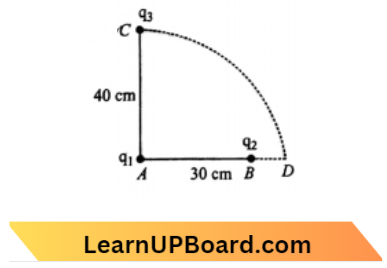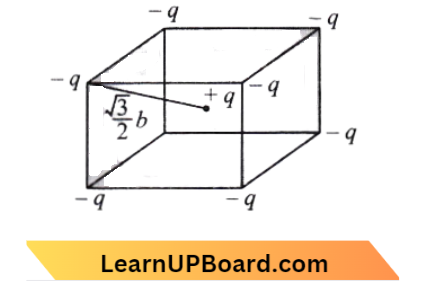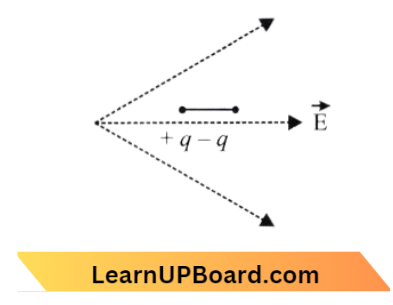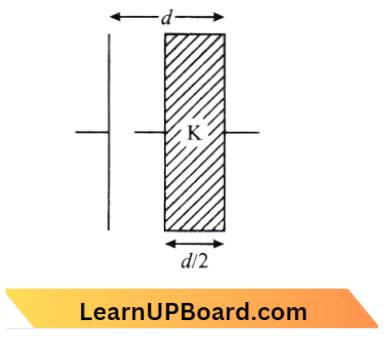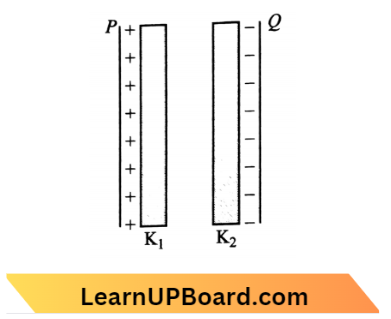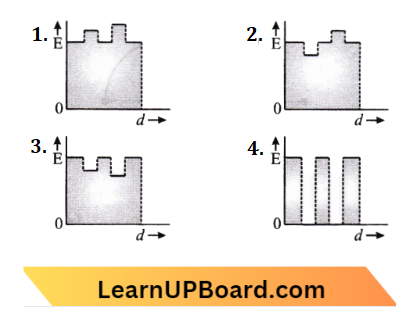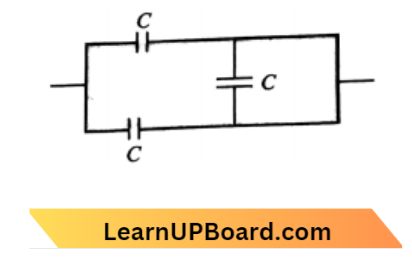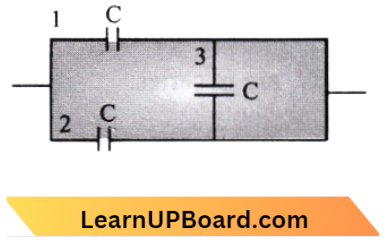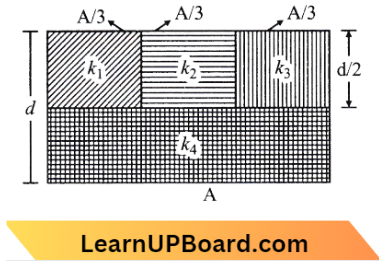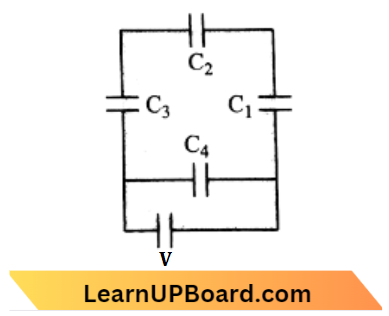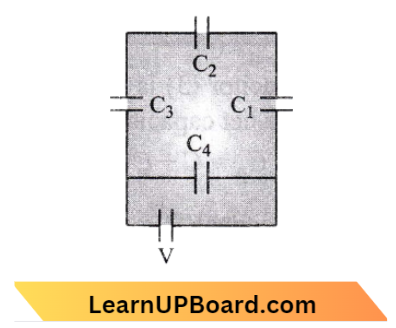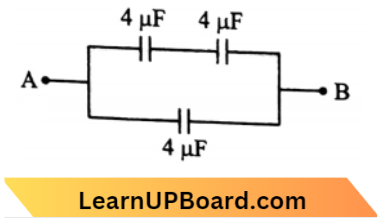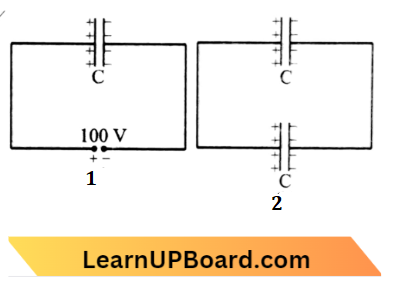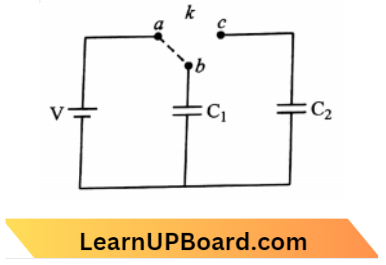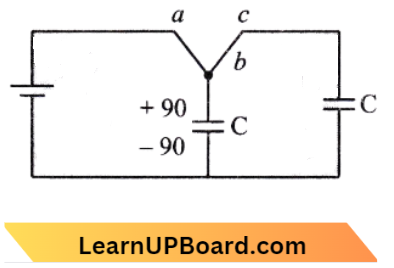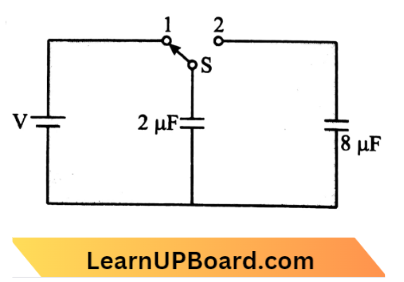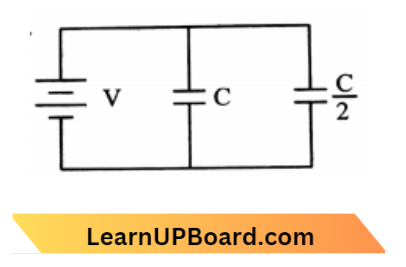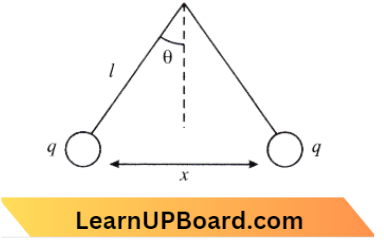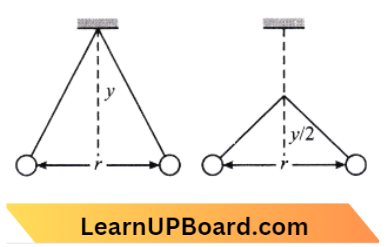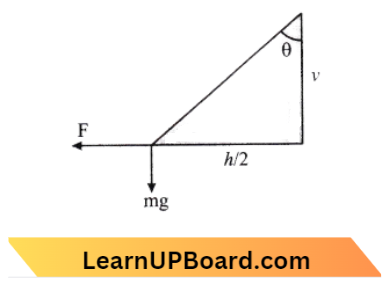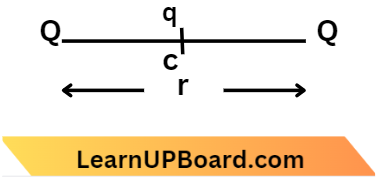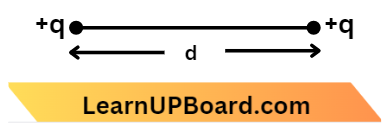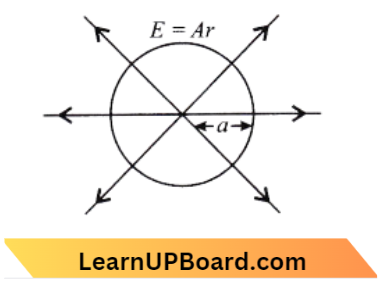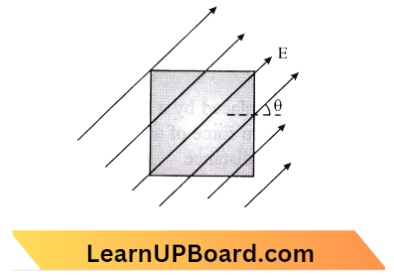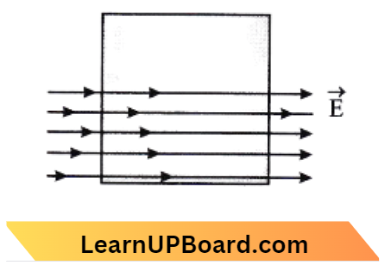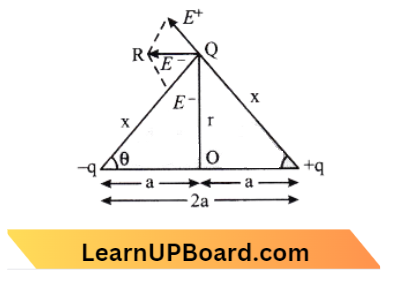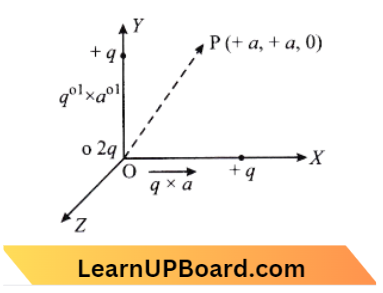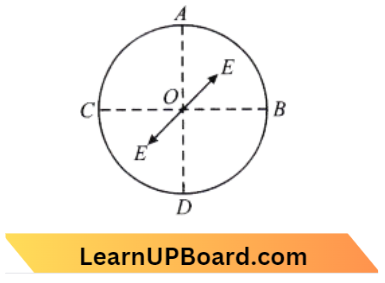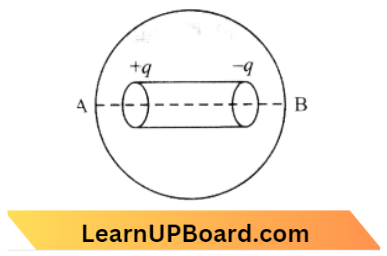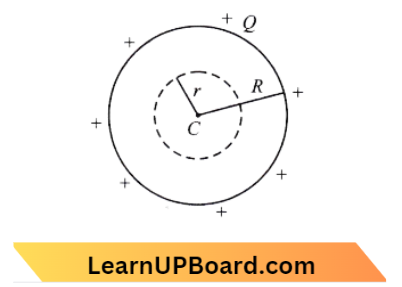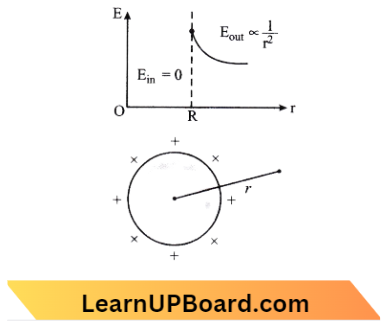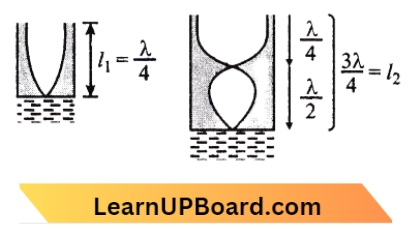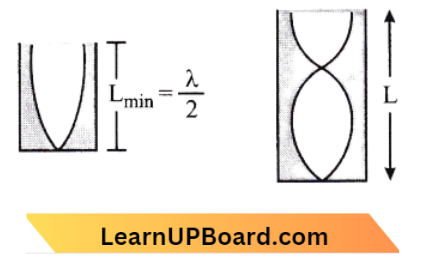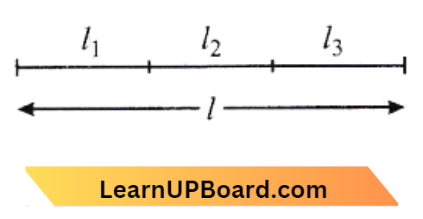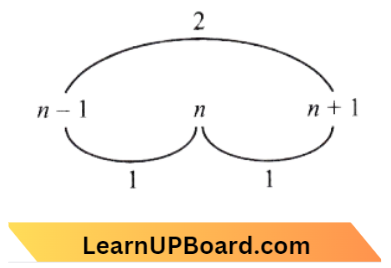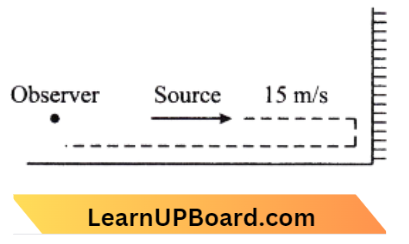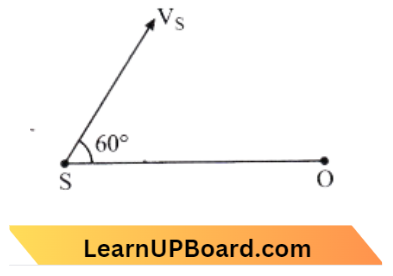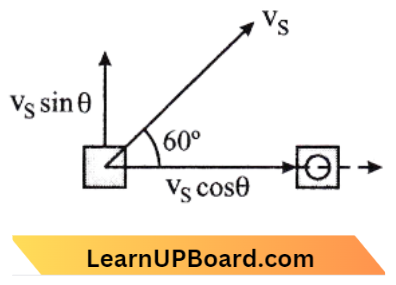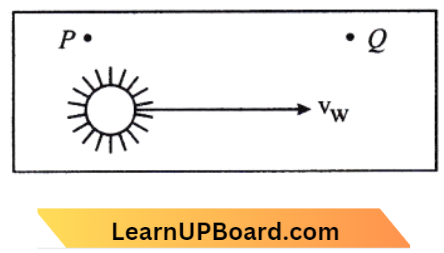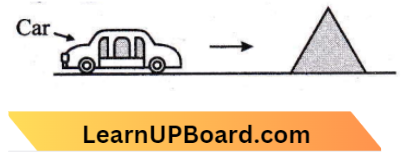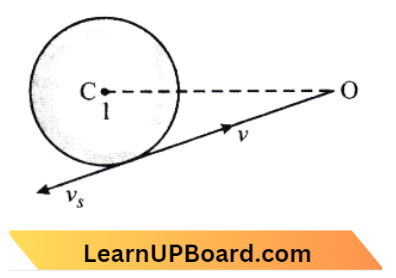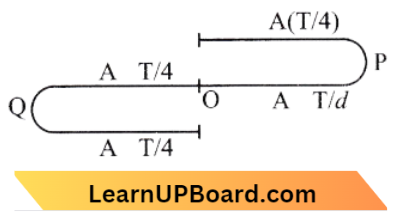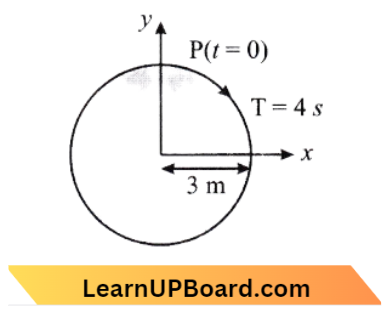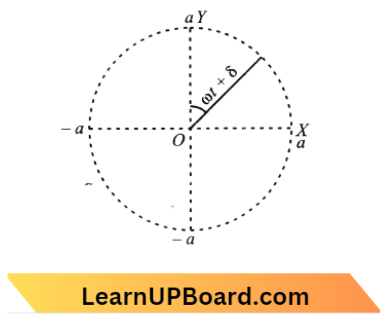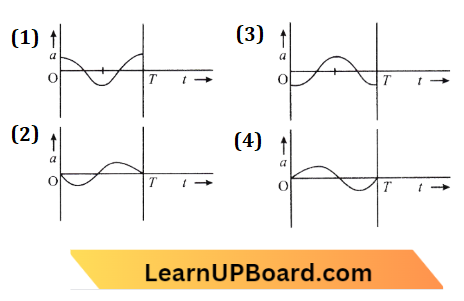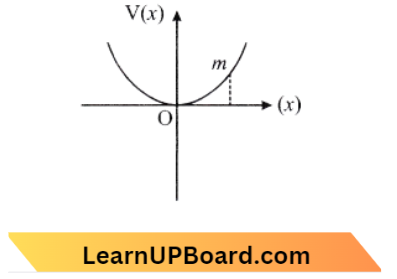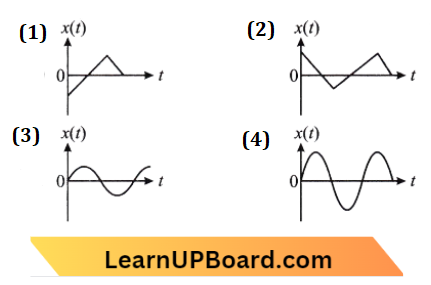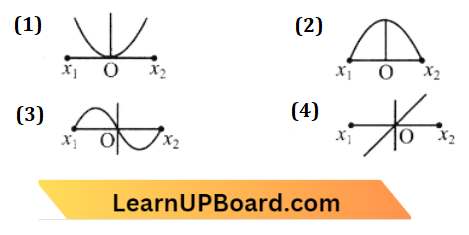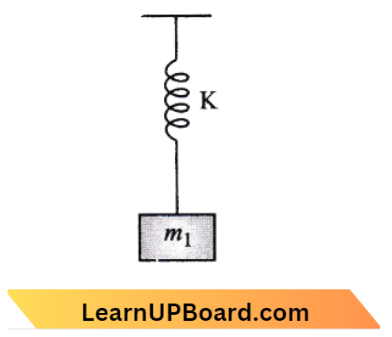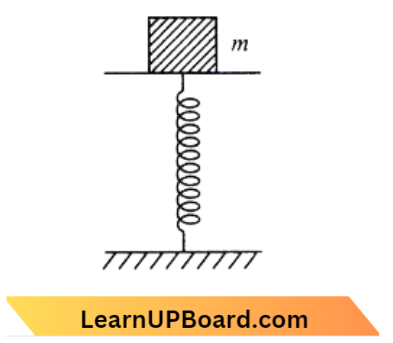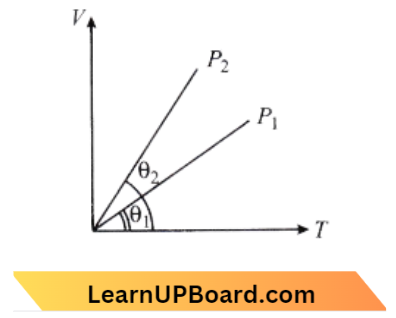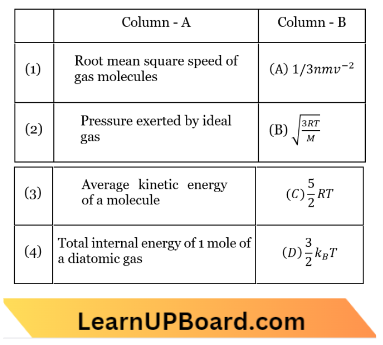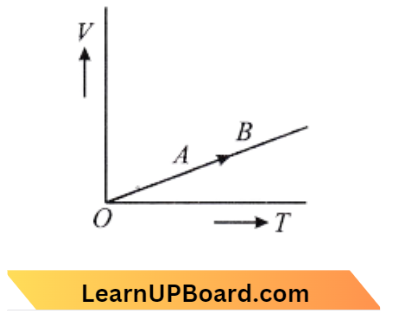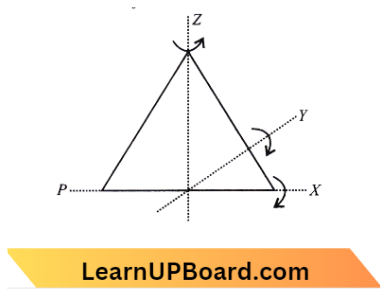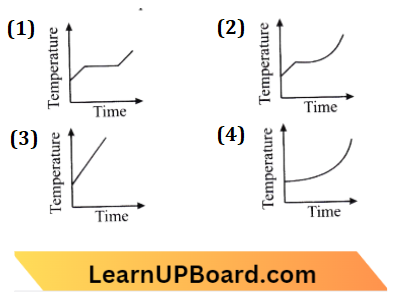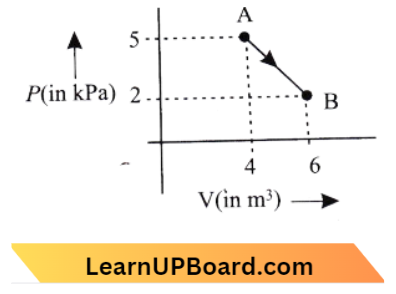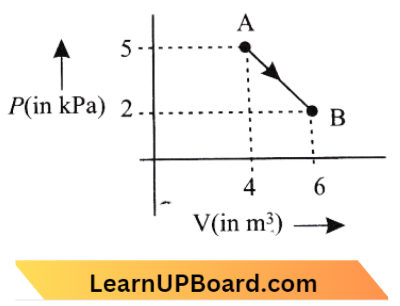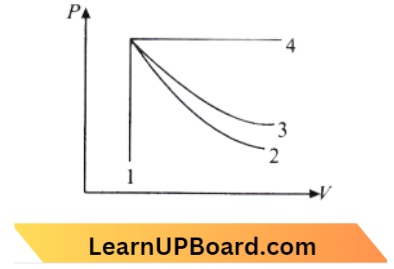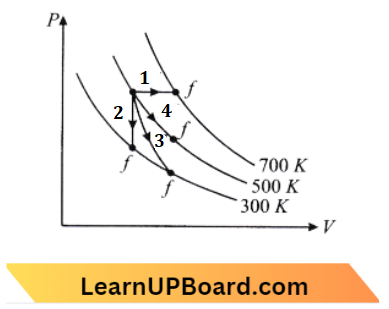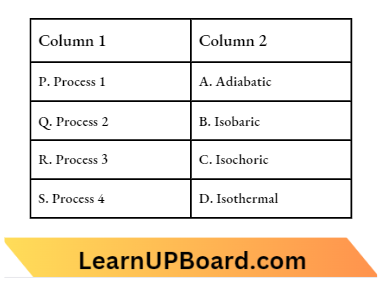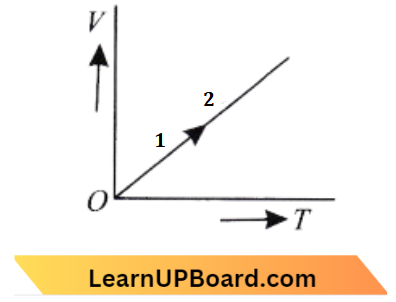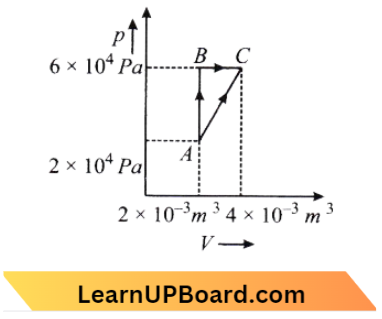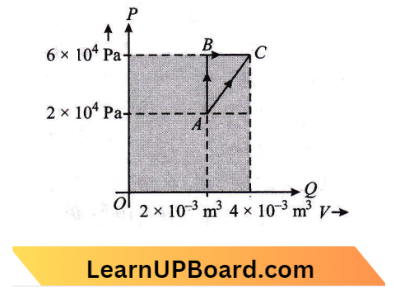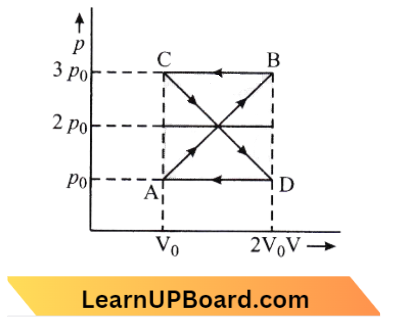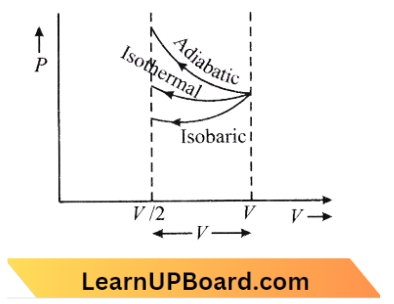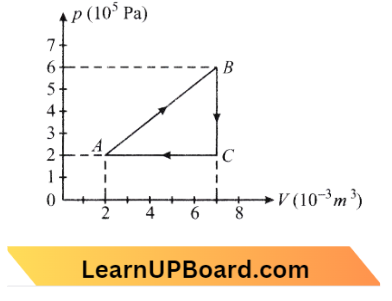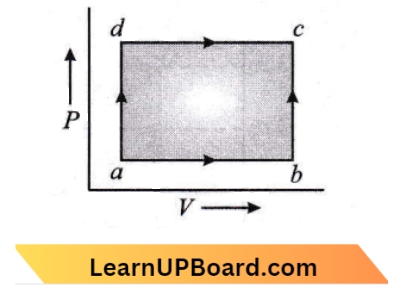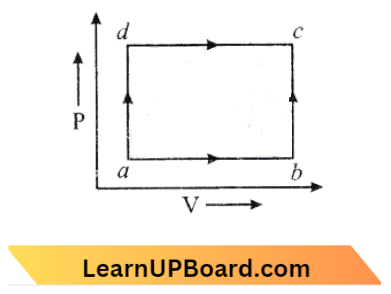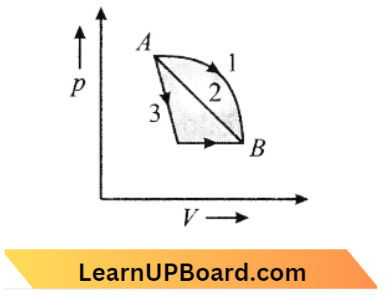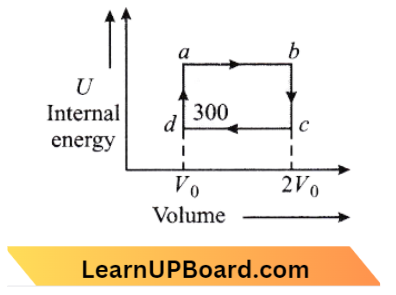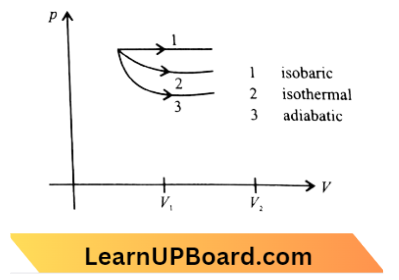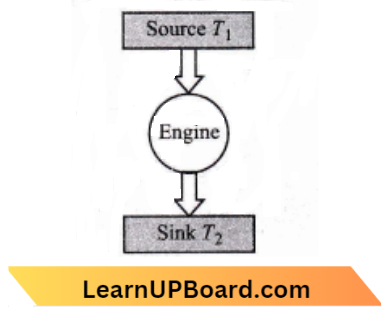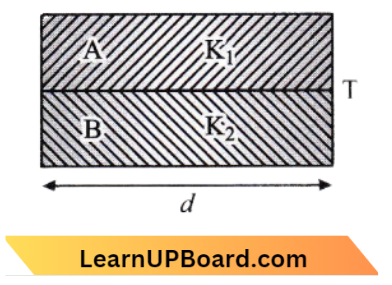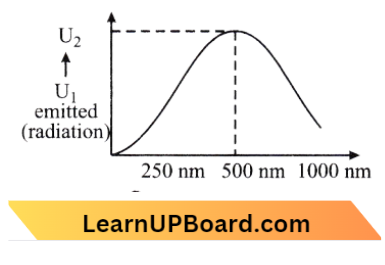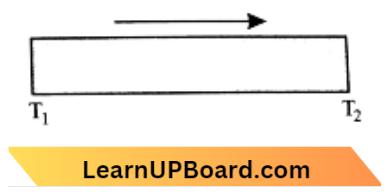NEET Physics For Moving Charges And Magnetism Multiple Choice Questions
Question 1. An infinitely long straight conductor carries a current of 5 A as shown. An electron is moving with a speed of 105 m/s parallel to the conductor. The perpendicular distance between the electron and the conductor is 20 cm at an instant. Calculate the magnitude of the force experienced by the electron at that instant: (Electron, v = 105 m/s)
- 4 x 10-20N
- 8π X 10-20N
- 4π x 10-20N
- 8 x 10-20N
Answer: 4. 8π x 10-20N
Given,
An infinitely long straight conductor carries a current of 5 A as shown. An electron is moving with a speed of 105 m/s parallel to the conductor. The perpendicular distance between the electron and the conductor is 20 cm at an instant.
I =5 \(\mathrm{~A}\)
⇒ \(V_e =10^5 \mathrm{~m} / \mathrm{s}\)
r =\(20 \mathrm{~cm}=0.2 \mathrm{~m}\)
We know that due to the magnetic field generated by the wire, the electron will experience a force,
F= \(q v \times B\)
Since the angle is \(90^{\circ}\) hence,
F =\(q v_e B\) → Equation 1
⇒ \(\mathrm{~B}=\frac{\mu_0 I}{2 \pi r} =2 \frac{\mu_0}{4 \pi} \frac{I}{r}\)
=2 \(\times 10^{-7} \times \frac{5}{0.2}\)
B =\(\frac{2 \times 50}{2} \times 10^{-7}\)
=5 \(\times 10^{-6}\) → Equation 2
From eqn (1),
F =1.6 \(\times 10^{-19} \times 10^5 \times 5 \times 10^{-6}\)
=8 \(\times 10^{-20} \mathrm{~N}\)
Question 2. A metallic rod of mass per unit length 0.5 kg m-1 is lying horizontally on a smooth inclined plane which makes an angle of 30° with the horizontal. The rod is not allowed to slide down by flowing a current through it when a magnetic field of induction 0.25 T is acting on it in the vertical direction. The current flowing in the rod to keep it stationary is:
- 14.76 A
- 5.98 A
- 7.14A
- 11.32 A
Answer: 4. 11.32 A
Given
A metallic rod of mass per unit length 0.5 kg m-1 is lying horizontally on a smooth inclined plane which makes an angle of 30° with the horizontal. The rod is not allowed to slide down by flowing a current through it when a magnetic field of induction 0.25 T is acting on it in the vertical direction.
According to the question, For equilibrium,
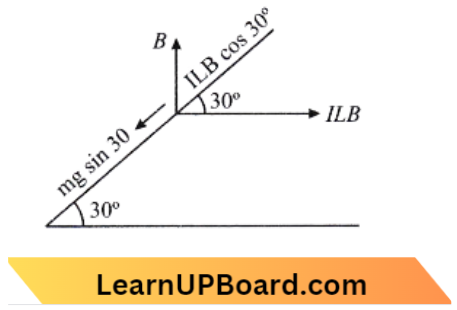
m g \(\sin 30^{\circ} =I l B \cos 30^{\circ}\)
I =\(\frac{m g}{l B} \tan 30^{\circ} \)
= \(\frac{0.5 \times 9.8}{0.25 \times \sqrt{3}}\)
⇒ \(\left.=1 \sin \theta=30^{\circ} B=0.25 \mathrm{~T}\right\}\)
= 11.32 \(\mathrm{~A}\)
Read and Learn More NEET Physics MCQs
Question 3. When a proton is released from rest in a room, it starts with an initial acceleration a0 towards the west. When it is projected towards the north with a speed v0 it moves with an initial acceleration 3a0 towards the west. The electric and magnetic fields in the room are:
- \(\frac{m a_0}{e}\) west, \(\frac{2 m a_0}{e v_0}\) up
- \(\frac{m a_0}{e}\) west, \(\frac{2 m a_0}{e v_0}\) down
- \(\frac{m a_0}{e}\) east, \(\frac{3 m a_0}{e v_0}\) up
- \(\frac{m a_0}{e}\) east, \(\frac{3 m a_0}{e v_0}\) down
Answer: 2. \(\frac{m a_0}{e}\) west, \(\frac{2 m a_0}{e v_0}\) down
Acceleration of charge particle,\(\vec{a}=\frac{q}{m}(\vec{E}+\vec{V} \times \vec{B})\)
Released from rest
a= \(\frac{q E}{m} \text { (west) } \)
E= \(\frac{m a_0}{e} \text { (west) }\)
When it is projected towards the north, acceleration due to magnetic force =2 \(a_0\)
Magnetic field =\(\frac{2 \cdot m a_0}{e v_0}( down )\)
Question 4. A long straight wire carries a certain current and produces a magnetic field \(2 \times 10^{-4} \frac{\text { Weber }}{\mathrm{m}^2}\) at a perpendicular distance of 5 cm from the wire. An electron situated at 5 cm from the wire moves with a velocity of 107 m/s towards the wire perpendicular to it. The force experienced by the electron will be (change on electron 1.6 x 10-19C):
- 3.2 N
- 3.2 x10-16N
- 1.6 x 10-16N
- Zero
Answer: 2. 3.2 x10-16N
Given
A long straight wire carries a certain current and produces a magnetic field \(2 \times 10^{-4} \frac{\text { Weber }}{\mathrm{m}^2}\) at a perpendicular distance of 5 cm from the wire. An electron situated at 5 cm from the wire moves with a velocity of 107 m/s towards the wire perpendicular to it.
From the question, Velocity of electron \(\mathrm{v}=10^7 \mathrm{~m} / \mathrm{s}\)

Magnetic field, B=2 \(\times 10^{-4} \mathrm{~Wb} / \mathrm{m}^2\)
Then magnitude of force experienced by the electron, i.e.
F=\(e v B \sin \theta\)
V and B are perpendicular to each other
= \(e v B \sin 90^{\circ}\)
=1.6 \(\times 10^{-19} \times 10^7 \times 2 \times 10^{-4} \times 1 \)
=3.2 \(\times 10^{-16} \mathrm{~N}\)
Question 5. A uniform electric field and a uniform magnetic field are acting along the same direction in a certain region. If an electron is projected in the region such that its velocity is pointed along the direction of fields, then the electron:
- speed with decreased
- speed with increase
- will turn towards the left of the direction of motion
- with a turn towards the right direction motion
Answer: 1. speed with decreased
According to the question, it is clear that field B does not apply force. Field E will apply a force opposite to the velocity of the electron this speed will decrease.
Question 6. The magnetic force acting on a charged particle of charge \(-2 \mu \mathrm{C}\) in a magnetic field of 2T acting in y direction, when the particle velocity is (\((2 \hat{i}+2 \hat{j}) \times 10^6 \mathrm{~ms}^{-1}\) is:
- 8 N in z-direction
- 4 N in z-direction
- 8 N in y-direction
- 4 N in z-direction
Answer: 1. 8 N in z-direction
Magnetic Lorentz force, \(\vec{F}=q(\vec{V} \times \vec{B})\)
⇒ \(\vec{F}=-2 \times 10^{-6}(2 \hat{i}+3 \hat{j})+2 \hat{j} \times 10^6\)
⇒ \(\vec{F}=-2 \times 10^{-6}(2 \hat{i}+2 \hat{j}) \times 10^6\)
∴ \(\vec{F}=-8 \hat{k} \mathrm{~N}\)
Question 7. When a charged particle moving with velocity \(\vec{v}\) is subjected to a magnetic field of induction \(\vec{B}\), the force on it is non-zero. This implies that:
- the angle between is either zero or 180°.
- the angle between is necessarily 90°.
- the angle between can have any value other than 90°.
- angle between can have any value other than zero and 180°.
Answer: 4. the angle between can have any value other than zero and 180°.
⇒ \(\vec{F} =q(\vec{V} \times \vec{B})\)
=\(q v B \sin \theta\)
Therefore, when \(\theta=0^{\circ}\) or \(\theta=180^{\circ}\)
F=0
Question 8. A very long straight wire carries a current I. At the instant when a charge + Q at point P has velocity v, as shown, the force on the charge is:

- along y
- opposite y
- along x
- opposite x
Answer: 1. along y
According to Fleming’s left-hand rule direction of force is along the axis when is perpendicular to the wire,
⇒ \(\vec{F}=Q(\vec{v} \times \vec{B})\)
B due to I is acting inwards is into the paper, \(\mathrm{v}\) is along or:
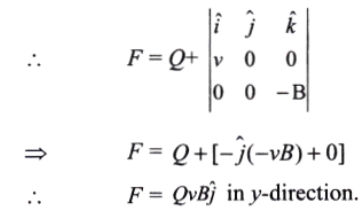
Question 9. A charge ‘q’ moves in a region where the electric field and the magnetic field both exist, then the force on it is:
- \(q(\vec{v} \times \vec{B})\)
- q \(\vec{E}+q(\vec{v} \times \vec{B})\)
- q \(\vec{E}+q(\vec{B} \times \vec{v})\)
- q \(\vec{E}+q(\vec{B} \times \vec{v})\)
Answer: 2. q \(\vec{E}+q(\vec{v} \times \vec{B})\)
Lorentz force, \(\vec{F}_v =\vec{F}_e+\vec{F}_m \)
= q \(\vec{E}+q(\vec{V} \times \vec{B})\)
Question 10. Tesla is the unit of:
- magnetic flux
- magnetic field
- magnetic induction
- magnetic moment
Answer: 3. magnetic field
SI unit of magnetic induction is tesla (T). If a charged particle of one coulomb moving at a right angle to a magnetic field with a velocity of lms-1 experiences a force of 1 N at that point, the magnetic field induction is said to be one tesla.
∴ \( 1 \mathrm{~T}=1 \mathrm{NA}^{-1} \mathrm{~m}^{-1}\)
Question 11. Ionized hydrogen atoms and a-particles with the same momenta enter perpendicular to a constant magnetic field, B. The ratio of the radii of their paths rH: ra will be:
- 1:2
- 4: 1
- 1: 4
- 2: 1
Answer: 4. 2: 1
From equation: \(q_{\mathrm{H}}=e \text { and } q_\alpha\)=2 e
For circular motion, \(\frac{m v^2}{r}\) =B q v
r =\(\frac{m v}{B q}\)
⇒ \(m_1 v_1\) and B are constant
r \(\propto \frac{1}{q} \)
∴ \(\frac{r_{\mathrm{H}}}{r_\alpha}=\frac{q_\alpha}{q_{\mathrm{H}}}=\frac{2 e}{e}=\frac{2}{1}\)=2: 1
Question 12. An electron is moving in a circular path under the influence of a transverse magnetic field of 3.57 x 10-2 T. If the value of E/M is 1.76 x 1011 C/kg, the frequency of revolution of the electron is:
- 1 GHz
- 100 MHz
- 62.8 MHz
- 6.28
Answer: 1. 1 GHz
The radius of a charged particle in a magnetic field is, \(r=\frac{m v}{q \mathrm{~B}}\)
And time taken to complete the circle, \(T=\frac{2 \pi r}{V}\)
⇒ \(\frac{T}{2 \pi}=\frac{m}{q B}\)
⇒ \(\omega=\frac{2 \pi}{T}=\frac{q B}{m}\)
Here, q=e, \(\frac{e}{m}=1.76 \times 10^{11} \mathrm{C} / \mathrm{kg}\)
and \(\frac{2 \pi}{T}=\frac{e B}{m}\)
⇒ \(\boldsymbol{f}=\frac{1}{2 \pi} \frac{e}{m} \mathrm{~B}\)
= \(\frac{1}{2 \pi} \times 1.76 \times 10^{11} \times 3.57 \times 10^{-2}\)
= \(1.0 \times 10^9 \mathrm{~Hz}\)
= 1GHz
Question 13. An electron moving in a circular orbit of radius r makes n rotations per second. The magnetic field produced at the center has magnitude:
- \(\frac{\mu_0 n e}{2 \pi r}\)
- zero
- \(\frac{\mu_0 n^2 e}{t}\)
- \(\frac{\mu_0 n e}{2 r}\)
Answer: 4. \(\frac{\mu_0 n e}{2 r}\)
We know that,
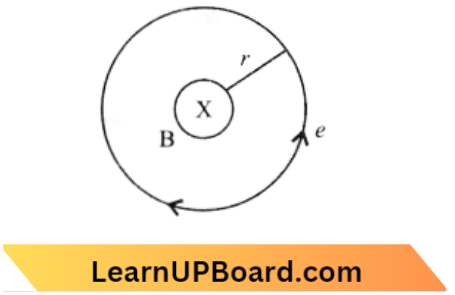
I=\(\frac{q}{t}\)
If an electron is moving in a circular orbit of radius r then,
q=e a\( \omega t\)=T
I =\(\frac{e}{T}=\frac{e}{\frac{2 \pi}{\omega}}\)
= \(\frac{\omega e}{2 \pi}=\frac{2 \pi n e}{2 \pi}\)=n e
∴ magnetic field produced at the centre is B=\(\frac{\mu_0 I}{2 R}=\frac{\mu_0 n e}{2 r}\)
Question 14. A proton and an alpha particle both enter a region of uniform magnetic field B, moving at right angles to the field B. If the radius of circular orbits for both the particles is equal and the kinetic energy acquired by the proton is 1 MeV, the energy acquired by the alpha particle will be:
- 4 MeV
- 0.5 MeV
- 1.5 MeV
- 1 MeV
Answer: 4.
Given
A proton and an alpha particle both enter a region of uniform magnetic field B, moving at right angles to the field B. If the radius of circular orbits for both the particles is equal and the kinetic energy acquired by the proton is 1 MeV,
We know that radius in magnetic fields of a circular orbit is R \(\mathrm{R}=\frac{m V}{q B}=\sqrt{\frac{2 m E}{q B}}\)
In a circular orbit, the total energy of a moving particle.
E= \(\frac{q^2 B^2 R^2}{2 m}\)
When a proton enters the region of the magnetic field then,
⇒ \(E_P =\frac{e^2 B^2 R^2}{2 m_{\mathrm{p}}}\) → Equation 1
⇒ \(M_P\) = mass of proton
Again when \alpha-particle enters the region of the magnetic field then,
⇒ \(E_\alpha=\frac{(2 e)^2 B^2 R^2}{2\left(4 m_{\mathrm{p}}\right)}\) → Equation 2
since \(m_\alpha=\Delta m_p \text { given }\}\)
Now from eq. (1) and (2)
⇒ \(\frac{E_\alpha}{E_p}=\frac{(2 e)^2 \times B^2 \times R^2}{2 \times 4 m_{\mathrm{p}}} \times \frac{2 \times m_{\mathrm{p}}}{e^2 \times B^2 \times P^2} \)
⇒ \(\frac{E_\alpha}{\dot{E}_p}\)=1
∴ \(E_\alpha=E_P=1 \mathrm{MeV} \)
Question 15. Under the influence of a uniform magnetic field, a charged particle moves with constant speed v in a circle of radius R. The period of rotation of the particle:
- depends on v and not on R
- depends on R and not on v
- is independent of both v and R
- depends on both v and R
Answer: 3. is independent of both v and R
The time period of the circular motion of the charged particles is
T=\(\frac{2 \pi r}{v}=\frac{2 \pi}{v} \times \frac{m v}{B q}\)
T=\(\frac{2 \pi m}{B q}\)
which is independent of both v and R
Question 16. A particle mass m, charge Q, and kinetic energy T enter a transverse uniform magnetic field of induction \(\vec{B}\)After 3 s the kinetic energy of the particle will be:
- 3 T
- 2T
- T
- AT
Answer: 3. T
After passing through a magnetic field, the magnitude of its mass and velocity of the particle remain the same, So its energy does not change i.e. K.E. will remain T.
Question 17. A charged particle moves through a magnetic field in a direction perpendicular to it. Then the:
- speed of the particle remains unchanged
- the direction of the particle remains unchanged
- acceleration remains unchanged
- velocity remains unchanged
Answer: 1. The speed of the particle remains unchanged
A charged particle moves through a magnetic field in a direction perpendicular to it. Then the speed of the particle remains unchanged
Question 18. A charged particle of charge q and mass m enters perpendicularly in a magnetic field B. The Kinetic energy of the particle is E, and the frequency of rotation is:
- \(\frac{q B}{m \pi}\)
- \(\frac{q B}{2 \pi m}\)
- \(\frac{q B E}{2 \pi m}\)
- \(\frac{q B}{2 \pi E}\)
Answer: 2. \(\frac{q B}{2 \pi m}\)
We have, Magnetic force = centripetal force
qvB =\(\frac{m v^2}{r}\)
qvB =\(m r \omega^2 \)
⇒ \(\omega^2 =\frac{q v B}{m r}=\frac{q(r \omega) B}{m r}\)
Angular frequency, \(\omega=\frac{q B}{m}\)
If v is the frequency of rotation, then \omega=2 \pi v
v=\(\frac{\omega}{2 \pi}\)
⇒ \(\mathrm{v}=\frac{q B}{2 \pi m}\)
Since the resultant expression\(\frac{q}{m}\) is known as a specific charge. It is sometimes denoted by \(\alpha\)
So, \(\omega=B \alpha \text { and } v=v=\frac{B \alpha}{2 \pi}\)
Question 19. Current is flowing in a coil of area A and number of turns N, then magnetic moment of the coil, M is equal to:
- NiA
- \(\frac{N i}{A}\)
- \(\frac{N i}{\sqrt{A}}\)
- \(N^2 A i\)
Answer: 1. NiA
If a coil contains N turns, I is the current running through it, and A is the coil’s area, then the magnetic dipole moment, or simply the magnetic moment of the coil, M = NiA
When a charged particle enters a magnetic field region at a velocity perpendicular to B, it takes a circular path
Question 20. A 10 eV electron is circulating in a plane at a right angle to a uniform field of magnetic induction 10-4 Wb/m2 (= 1.0 gauss). The orbital radius of the electron is:
- 12 cm
- 16 cm
- 11cm
- 18 cm
Answer: 3. 11cm
A maximum force acting perpendicular to the direction of B, as well as v, is experienced by a charged particle moving perpendicular to the direction of B. As a result of this force, the charged particle will travel a circular path in the magnetic field of radius r, which is given by,
⇒ \(\frac{m v^2}{r}=q v B\)
Now, \(\mathrm{KE} of electron =10 \mathrm{eV}\)
⇒ \(\frac{1}{2} m v^2 =10 \mathrm{eV} \)
⇒ \(\frac{1}{2} \times\left(9.1 \times 10^{-31}\right) v^2 =10 \times 1.6 \times 1.6 \times 10^{-19}\)
⇒ \(v^2 =\frac{2 \times 10 \times 1.6 \times 10^{-19}}{9.1 \times 10^{-31}}\)
⇒ \(v^2 =3.52 \times 10^{12}\)
v =1.88 \(\times 10^6 \mathrm{~m}\)
or Now the radius of the circular path,
r=\(\frac{m v}{q b}=\frac{9.1 \times 10^{-31} \times 1.88 \times 10^6}{1.6 \times 10^{-19} \times 1^{-4}}=11 \mathrm{~cm}\)
Question 21. A uniform magnetic field acts right angles to the direction of motion of an electron. As a result, the electron moves in a circular path of radius 2 cm. If the speed of electrons is doubled, then the radius of the circular path will be:
- 2.0 cm
- 0.5 cm
- 4.0 cm
- 1.0 cm
Answer: 3. 4.0 cm
The centripetal force (= \(\mathrm{mv}^2 / \mathrm{r})\) required for motion along a circular path of radius r is generated by the external magnetic field’s force F on the charged particle.
⇒ \(q v B =\frac{m v^2}{r} \text { or } r=\frac{m v}{q B} \)
r \(\propto \mathrm{V}[\frac{m}{q B}=\text { constant }]\)
∴ When v is doubled, the radius is also doubled, Hence, radius r = 2 x 2 = 4 cm.
Question 22. An alternating electric field of frequency v is applied across the dees (radius = R) of a cyclotron that is being used to accelerate protons (mass = m). The operating magnetic field used in the cyclotron and the kinetic energy (K) of the proton beam, produced by it, are given by:
- B=\(\frac{m v}{e} and K=2 m \pi^2 R^2\)
- B=\(\frac{2 \pi m v}{e} and K=m^2 \pi v R^2\)
- B=\(\frac{2 \pi m v}{e} and K=2 m \pi^2 v^2 R^2\)
- B=\(\frac{m v}{e} and K=m^2 \pi v R^2\)
Answer: 3. B=\(\frac{2 \pi m v}{e} and K=2 m \pi^2 v^2 R^2\)
Given
An alternating electric field of frequency v is applied across the dees (radius = R) of a cyclotron that is being used to accelerate protons (mass = m). The operating magnetic field used in the cyclotron and the kinetic energy (K) of the proton beam
We Know That
Frequency,v =\(\frac{e \mathrm{~B}}{2 \pi m}\),
⇒ \(\mathrm{KE} =\frac{1}{2} m v^2 a w\)
R =\(\frac{m v}{e B}\)
Radius,R=\(\frac{m v}{e B}\)
Velocity, v=\(\frac{\pi R}{T / 2}=\frac{2 \pi R}{T}=2 \pi R v\)
Radius, R=\(\frac{m(2 \pi R v)}{e B}\)
Magnetic field, B =\(\frac{2 \pi m v}{e} \)
⇒ \(\mathrm{KE} =\frac{1}{2} m v^2=\frac{1}{2} m(2 \pi \mathrm{R} v)^2\)
= \(2 m \pi^2 v^2 R^2\)
Question 23. A beam of cathode rays is subjected to crossed Electric field (E) and Magnetic field (B). The fields are adjusted such that the beam is not deflected. The specific charge of the cathode rays is given by:
- \(\frac{B^2}{2 V E^2}\)
- \(\frac{2 V B^2}{E^2}\)
- \(\frac{2 V E^2}{B}\)
- \(\frac{E^2}{2 V B^2}\)
Answer: 4. \(\frac{E^2}{2 V B^2}\)
Given
A beam of cathode rays is subjected to crossed Electric field (E) and Magnetic field (B). The fields are adjusted such that the beam is not deflected.
According to the law of conservation of energy,
e V =\(\frac{1}{2} m v^2 \)
V = \(\sqrt{\frac{2 \mathrm{e} V}{m}}\) → Equation 1
The condition is, that the electron beam is not deflected then
⇒ \(F_m =F_e \)
⇒ \(B_e v =E_e \)
v =\(\frac{E}{B}\) → Equation 2
From eq. (1) and (2),
⇒ \(\frac{E}{B} =\sqrt{\frac{2 \mathrm{eV}}{m}} \)
⇒ \(\frac{E^2}{B^2} =\frac{2 \mathrm{eV}}{m}\)
∴ \(\frac{e}{m} =\frac{E^2}{2 V B^2}\)
Question 24. A particle having a mass of \(10^{-2}\) kg carries a charge of 5 x \(10^{-8}\) C. The particle is given an initial horizontal velocity of \(10^5 \mathrm{~ms}^{-1}\) in the presence of an electrical field \(\vec{E}\) and magnetic field \(\vec{B}\). To keep the particle moving in a horizontal direction, it is necessary that:
1. \(\vec{B}\) should be perpendicular to the direction of velocity \(\vec{E}\) should be along the direction of velocity.
2. Both \(\vec{B}\) and \(\vec{E}\) should be along the direction of velocity.
3. Both \(\vec{B}\) and \(\vec{E}\) are mutually perpendicular and perpendicular to the direction of velocity.
4. \(\vec{B}\) should be along the direction of velocity and \(\vec{E}\) should be perpendicular to the direction of velocity.
Which one of the following pairs of statements is possible?
- (A)(1) and (3)
- (B)(3) and (4)
- (2) and (3)
- (2) and (4)
Answer: 3. (2) and (4)
Both \(\vec{B}\) and \(\vec{E}\) should be along the direction of velocity.
Both \(\vec{B}\) and \(\vec{E}\) are mutually perpendicular and perpendicular to the direction of velocity.
Question 25. A beam of electrons passes undeflected through mutually perpendicular electric and magnetic fields. If the electric field is switched off, and the same magnetic field is maintained, the electrons move:
- in a circular orbit
- along a parabolic path
- along a straight line
- in an elliptical orbit.
Answer: 1. in a circular orbit
In the magnetic field a charged particle moves in a circular orbit.
Question 26. In a mass spectrometer for measuring the masses of ions, the ions are initially accelerated by an electric potential V and then made to describe semicircular paths of radius R using a magnetic field B. If V and B are kept constant, the \(\left(\frac{\text { charge on the ion }}{\text { mass of the ion }}\right)\) will be proportional to:
- \(\frac{1}{R^2}\)
- \(R^2\)
- R
- \(\frac{1}{R}\)
Answer: 1. \(\frac{1}{R^2}\)
The radius of the semicircular path
R=\(\frac{m v}{q B}=\frac{\sqrt{2 m q V}}{q B}\)
As V and B are constant so,
R \(\propto \frac{\sqrt{m q}}{q}\)
∴ \(\frac{q}{m} \propto \frac{1}{R^2}\)
Question 27. Below are two statements:
Statement 1: Biot-Savart’s law gives us the expression for the magnetic field strength of an infinitesimal current element (M) of a current-carrying conductor only.
Statement 2: Biot-Savart’s law is analogous to Coulomb’s inverse square law of charge q, with the former being related to the field produced by a scalar source, Idl while the latter being produced by a vector source, q. In light of the above statements choose the most appropriate answer from the options given below:
- Both Statement 1 and Statement 2 are correct.
- Both Statement 1 and Statement 2 are incorrect.
- Statement 1 is correct and Statement 2 is incorrect.
- Statement 1 is incorrect and Statement 2 is correct
Answer: 3. Statement 1 is correct and Statement 2 is incorrect.
According to Biot – Savart’s law, dB=\(\frac{\mu_0(I d l \times r)}{4 \pi r^3}\)
Here, the current element Idl is a vector quantity and the coulomb’s force is produced by scalar source q. Hence statement – 1 is correct, but statement – 2 is incorrect.
Question 28. An electron is moving in a circular path under the influence of a transverse magnetic field of 3.57 x 10-2 T. If the value of e/m is 1.76 x 1011 C/kg, the frequency of revolution of the electron is:
- 1 GHz
- 100 MHz
- 62.8 MHz
- 6.28 MHz
Answer: 1. 1 GHz
Given
An electron is moving in a circular path under the influence of a transverse magnetic field of 3.57 x 10-2 T. If the value of e/m is 1.76 x 1011 C/kg,
Radius of charged particle in magnetic field is, r=\(\frac{m v}{q B}\)
and time taken to complete the circle
⇒ \(\mathrm{T} =\frac{2 \pi r}{V}\)
⇒ \(\frac{T}{2 \pi} =\frac{m}{q B}\)
⇒ \(\omega =\frac{2 \pi}{T}-\frac{q B}{m}\)
Here \(\mathrm{q}= e. \frac{e}{m}=1.76 \times 10^{11} \mathrm{C} / \mathrm{kg}\)
Here \(\mathrm{q}=\text { e. } \frac{e}{m}=1.76 \times 10^{11} \mathrm{C} / \mathrm{kg} \)
and \(\frac{T}{2 \pi} =\frac{e B}{m}\)
= \(\frac{1}{2 \pi} \frac{e}{m} \mathrm{~B} \)
= \(\frac{1}{2 \pi} \times 1.76 \times 10^{11} \times 3.57 \times 10^{-2} \)
= \(1.0 \times 10^9 \mathrm{~Hz}\)
= 1 \(\mathrm{GHz}\)
Question 29. A long wire carrying a steady current is bent into a circular loop of one turn. The magnetic field at the center of the loop is B. It is then bent into a circular coil of n turns. The magnetic field at the center of the coil of n turns will be:
- nB
- n²B
- 2nB
- 2n²B
Answer: 2. n²B
Given
A long wire carrying a steady current is bent into a circular loop of one turn. The magnetic field at the center of the loop is B. It is then bent into a circular coil of n turns.
Since, l=2\( \pi R=n(2 \pi r)\)
r=\(\frac{R}{n}\)
for one turn B=\(\frac{\mu_0 I}{2 R}\)
for n turn \(B^{\prime}=\frac{\mu_0 n I}{2 r}\)
⇒ \(B^{\prime} =\frac{\mu_0 n^2 I}{2 R}=n^2\left(\frac{\mu_0 I}{2 R}\right)\)
∴ \(B^{\prime} =n^2 B\)
Question 30. A wire carrying current I has the shape as shown in the adjoining figure. Linear parts of the wire are very long and parallel to the X-axis while a semicircular portion of radius R lies in the Y-Z plane. The magnetic field at point O is:
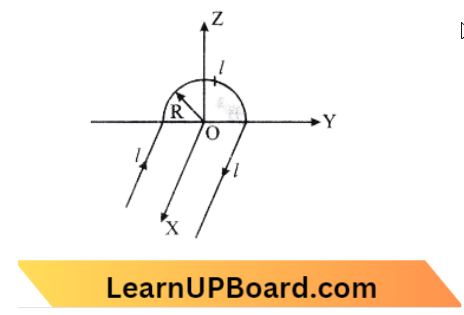
- B=\(\frac{\mu_0}{4 \pi} \frac{I}{R}(\pi \hat{i}+2 \hat{k})\)
- B=\(\frac{\mu_0}{4 \pi} \frac{I}{R}(\pi \hat{i}-2 \hat{k})\)
- B=\(\frac{\mu_0}{4 \pi} \frac{I}{R}(\pi \hat{i}+2 \hat{k})\)
- B=\(\frac{\mu_0}{4 \pi} \frac{I}{R}(\pi \hat{i}-2 \hat{k})\)
Answer: 4. B=\(\frac{\mu_0}{4 \pi} \frac{I}{R}(\pi \hat{i}-2 \hat{k})\)
Magnetic field due to wire parallel to the x-axis is, \(B_I=\frac{\mu_0}{4 \pi} \frac{I}{R}(-\hat{k})\)
Magnetic field due to another wire parallel to the x-axis is, \(B_{I I I}=\frac{\mu_0}{4 \pi} \frac{I}{R}(-\hat{k})\)
Magnetic field due to half semi-circular wire is, \(B_{I I}=\frac{\mu_0 I}{4 R}(\hat{i})\)
Magnetic field at the centre of wire is, B =\(B_I+B_{I I}+B_{I I I}\)
= \(\frac{\mu_0 I}{4 \pi R}(-2 \hat{k}+\pi \hat{i})\)
Question 31. A current loop consists of two identical semicircular parts each of radius R, one lying in the x-y plane and the other in the x-z plane. If the current in the loop is i. The resultant magnetic field due to the two semicircular parts at their common center is
- \(\frac{\mu_0 i}{2 \sqrt{2} R}\)
- \(\frac{\mu_0 i}{2 R}\)
- \(\frac{\mu_0 i}{4 R}\)
- \(\frac{\mu_0 i}{\sqrt{2 R}}\)
Answer: 1. \(\frac{\mu_0 i}{2 \sqrt{2} R}\)
The radius of the semi-circular part = R then the magnetic field
⇒ \(B_1=B_2 \frac{\mu_0 l}{4 \mathrm{R}}\)
Then magnetic field at their common center will be:
⇒ \(\vec{B} =\vec{B}_1+\vec{B}_2\)
⇒ \(|\vec{B}| =\sqrt{\left(\frac{\mu_0 i}{4 R}\right)^2+\left(\frac{\mu_0 i}{4 R}\right)^2}\)
B =\(\frac{\mu_0 i}{2 \sqrt{2} R}\)
Question 32. Two circular coils 1 and 2 are made from the same wire but the radius of the 1st coil is twice that of the 2nd coil. What potential difference in volts should be applied across them so that the magnetic field at their centers is the same?
- 2
- 3
- 4
- 6
Answer: 3. 4
Let \(r_1\) and \(r_2\) be the radius of coil 1 and coil 2. If \(B_1\) and \(B_2\) are magnetic induction at their centre then,
⇒ \(B_1=\frac{\mu_0 I_1}{2 r_1}\) and \(B_2=\frac{\mu_0 I_2}{2 r_2}\)
⇒ \(B_1=B_2\) and \(r_1=2 r_2\) there \(I_1=2 I_2\)
Again if \(R_1\) and \(R_2\) are resistance of the coil 2 then \(R_1=2 R_2 \)(as R \(\propto\) length =\(2 \pi r\)) and if \(V_1 and V_2\) are the potential difference across them respectively then,
⇒ \(\frac{V_1}{V_2}=\frac{I_1 R_1}{I_2 R_2} \)
= \(\frac{\left(2 I_2\right)\left(2 R_2\right)}{I_2 R_2}\)=4
Question 33. An electron moves in a circular orbit with a uniform speed v. It produces a magnetic field B at the center of the circle. The radius of the circle is proportional to
- \(\sqrt{\frac{B}{v}}\)
- \(\frac{B}{v}\)
- \(\sqrt{\frac{v}{B}}\)
- \(\frac{v}{B}\)
Answer: 3. \(\sqrt{\frac{v}{B}}\)
The magnetic field is produced by moving electrons in a circular path,

B=\(\frac{\mu_0 I}{2 r} \)
where, I=\(\frac{\rho}{t}=\frac{\rho}{2 \pi r} \times v\)
B=\(\frac{\mu_0 \rho v}{4 \pi r^2}\)
r \(\propto \sqrt{\frac{\nu}{B}} \)
Question 34. The magnetic field of a given length of wire for a single turn coil at the center is ‘B’ then, its value for two turns coil for the same wire is:
- \(\frac{B}{4}\)
- \(\frac{B}{2}\)
- 4B
- 2B
Answer: 3. 4B
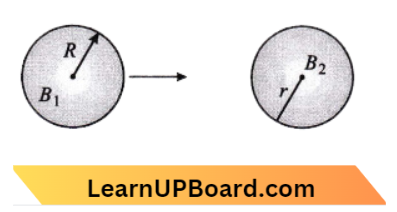
Here \(B_1 =B=\frac{\mu_0 I}{2 R}\)
⇒ \(B_2 =\frac{\mu_0(2 \mathrm{I})}{2 r}\)
2 \(\times 2 \pi r =2 \pi R \)
r =\(R / 2\)
Question 35. From Ampere’s circuital law for a long straight wire of circular cross-section carrying a steady current, the variation of the magnetic field in the inside and outside region of the wire is:
- uniform and remains constant for both the regions
- a linearly increasing function of distance up to the boundary of the wire and then linearly decreasing for the outside region
- a linearly increasing function of distance r up to the boundary of the wire and then decreasing one with Hr dependence for the outside region
- a linearly decreasing function of distance up to the boundary of the wire and then a linearly increasing one for the outside region.
Answer: 3. a linearly increasing function of distance r up to the boundary of the wire and then decreasing one with Hr dependence for the outside region
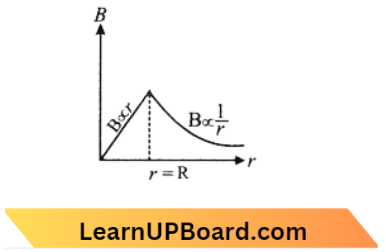
According to ampere’s circuital label, \(\mathrm{B}_{\text {in }} =\frac{\mu_0 I r}{2 \pi a^2} \text { or } \mathrm{B}_{\text {in }} \propto r\)
∴ \(\mathrm{~B}_{\text {out }} =\frac{\mu_0 I}{2 \pi r} \text { or } \mathrm{B}_{\text {out }} \propto \frac{1}{r}\)
Question 36. A thick current-carrying cable of radius R’ carries current I uniformly distributed across its cross-section. The variation of magnetic field B(r) due to the cable with the distance V from the axis of the cable is represented by
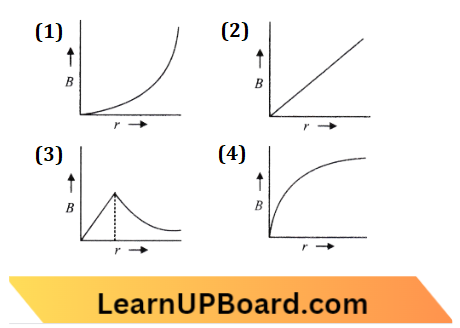
Answer: 3.
Inside the field drops linearly while outside it drops as a power of two.
Question 37. A cylindrical conductor of radius R is carrying a constant current. The plot of the magnitude of the magnetic field B with the distance d from the center of the conductor is correctly represented by the figure:
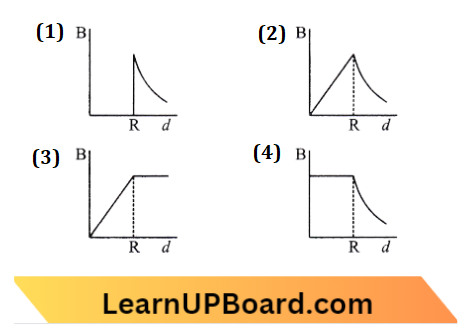
Answer: 2.
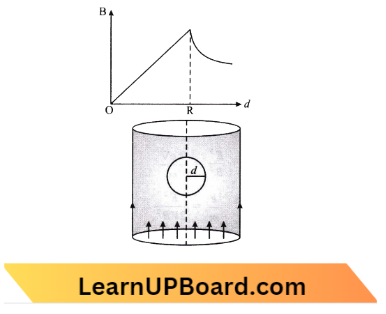
Inside \((d<R)\)
Magnetic field inside conductor,
B=\(\frac{\mu_0}{2 \pi R^2} I d\)
Or B=k d → Equation 1
A straight line passing through the origin, At surface (d=R)
B=\(\frac{\mu_0}{2 \pi} \frac{I}{R}\) → Equation 2
Maximum at surface, Outside \((d>\mathrm{R})\)
B =\(\frac{\mu_0}{2 \pi} \frac{I}{d}\)
B \(\propto \frac{I}{d} \text { (Hyperbolic) }\)
Question 38. A long straight wire of radius a carries a steady current L. The current is uniformly distributed over its cross-section. The ratio of the magnetic field B and B’ at a radial distance\(\frac{a}{2}\)and 2a respectively, from the axis of the wire is:
- \(\frac{1}{2}\)
- 1
- 4
- \(\frac{1}{4}\)
Answer: 2. 1
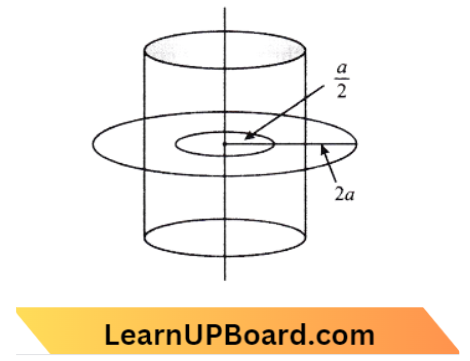
Here two Amperian loops of radius \(\ \frac {a}{2}\) and 2 a are shown from Ampere’s Circuital law
⇒ \(\oint B \cdot d L=\mu_0 I_{\text {enclosed }}\)
∴ for small loops,
\(\mathrm{B} \times 2 \pi \frac{a}{2} =\mu_0 \times \frac{\mathrm{I}}{\pi a^2} \times \pi\left(\frac{a}{2}\right)^2\)= \(\frac{\mu_0 I}{4}\)
B =\(\frac{\mu_0 I}{4}\) → Equation 1
Similarly for bigger loops,
⇒ \(B^{\prime} \times 2 \pi(2 a) =\mu_0 I\)
⇒ \(B^{\prime} =\frac{\mu_0 I}{4 \pi a}\) → Equation 2
∴ \(B^{\prime} =\frac{\mu_0 I}{4 \pi a} \times \frac{4 \pi a}{\mu_0 I}\)=1
Question 39. Two identical long conducting AOB and COD are placed at right angle wires to each other with one above the other such that O is their common point for the two. The wires carry I1 and I2 currents respectively. Point P is lying at distance d from O along a direction perpendicular to the plane containing the wires. The magnetic field at the point P will be :
- \(\frac{\mu_0}{2 \pi d}\left(\frac{I_1}{I_2}\right)\)
- \(\frac{\mu_0}{2 \pi d}\left(I_1+I_2\right)\)
- \(\frac{\mu_0}{2 \pi d}\left(I_1^2-I_2^2\right)\)
- \(\frac{\mu_0}{2 \pi d}\left(I_1^2+I_2^2\right)\)
Answer: 4. \(\frac{\mu_0}{2 \pi d}\left(I_1^2+I_2^2\right)\)
Given
Two identical long conducting AOB and COD are placed at right angle wires to each other with one above the other such that O is their common point for the two. The wires carry I1 and I2 currents respectively. Point P is lying at distance d from O along a direction perpendicular to the plane containing the wires.
According to the questions.
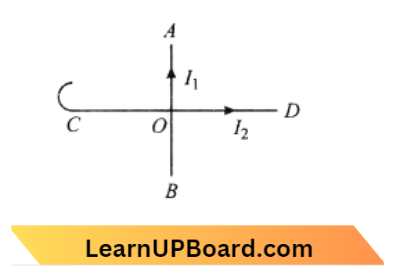
Two wires AOB and COD are placed at a right angle. O is the common point.
⇒ \(I_1\) and \(I_2\) are current flowing in the wires.
Point P is lying at distance d along the 2 -axis So
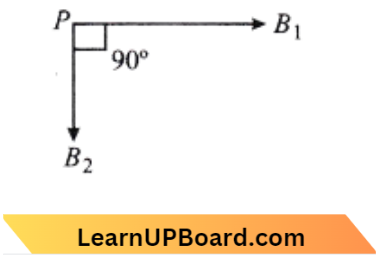
⇒ \(\left|B_1\right|=\frac{\mu_0}{2 \pi} \frac{I_1}{d} \)
⇒ \(\left|B_2\right|=\frac{\mu_0}{2 \pi} \frac{I_2}{d}\)
⇒ \(B_net =\sqrt{B_1^2+B_2^2}\)
=\(\sqrt{\left(\frac{\mu_0}{2 \pi} \times \frac{I_1}{d}\right)^2+\left(\frac{\mu_0}{2 \pi} \times \frac{I_2}{d}\right)^2}\)
=\(\frac{\mu_0}{2 \pi} \frac{\left(I_1^2+I_2^2\right)}{d}\)
Question 40. If a long hollow copper pipe carries a current, then a magnetic field is produced:
- inside the pipe only
- outside the pipe only
- both inside and outside the pipe
- nowhere
Answer: 2. outside the pipe only
According to Ampere’s circuital law,
⇒ \(\int B \cdot d I =\mu_0 I_enclosed\)
so, B\((2 \pi r) =\mu_0 \times 0 \quad\left[I_{\text {enclosed }}=0\right] \)
B =0
Since there is no current inside the Ampere’s surface
in a hollow metallic (copper) pipe, hence, the magnetic field is zero.
For external points, however, the entire current behaves as if it were concentrated along the axis.
So outside \(\tilde{B}_0=\frac{\mu_0 I}{2 \pi r}\)
Thus, the magnetic field is only created outside the pipe.
Question 41. A coil of one turn is made of a wire of a certain length and then from the same length a coil of two turns is made. If the same current is passed in both cases, then the ratio of the magnetic induction at their centers will be:
- 2:1
- 1:4
- 4:1
- 1:2
Answer: 2. 1:4
Magnetic induction at the center of a current-carrying coil with \(\mathrm{N}\) turns is equal to
⇒ \(\mathrm{B}=\frac{\mu_0 N I}{2 r}\)
Suppose the length of the wire is L.
Case 1: For coil of one turn, let radius be \(r_1\).
L =2 \(\pi r_1 \times N \)
or \(r_1=\frac{L}{2 \pi \times N}=\frac{L}{2 \pi}\) (N=1)
Case 2: For a coil of two turns, let the radius be \(r_2\).
L=2 \(\pi r_2 \times N \)
or \(r_2=\frac{L}{2 \pi \times N}=\frac{L}{2 \pi \times 2}\)( N=2)
or \(r_2=\frac{r_1}{2}\)
By comparing two different cases from Eq. (1), we get,
or \(\frac{B_1}{B_2}=\frac{N_1}{r_1} \times \frac{r_2}{N_2}\)
∴ \(\frac{B_1}{B_2}=\frac{1}{4}\)
Question 42. Two equal electric currents are flowing perpendicular to each other as shown in the figure. AB and CD are perpendicular to each other and symmetrically placed w.r.t the currents, where do we expect the resultant magnetic field to be zero?
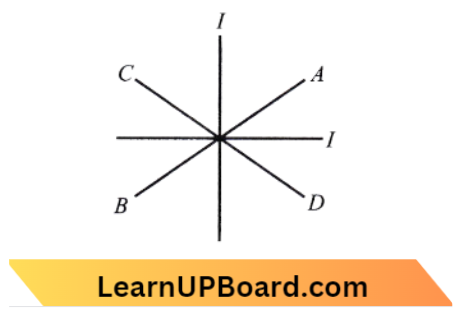
- On AB
- On CD
- On both AB and CD
- On both OD and BO
Answer: 1. On AB
Using the right-hand grip rule and considering AB, the magnetic field corresponding to one current is upwards and the magnetic field due to the other is downwards. Both magnetic fields cancel each other out, and the resultant magnetic field is zero. When considering CD and applying the right-hand grip rule to the two currents, the magnetic field direction is the same in both cases, resulting in a non-zero resultant.
Question 43. A straight wire of diameter 0.5 mm carrying a current of 1 A is replaced by another wire of 1mm diameter carrying the same current. The strength of the magnetic field far away is:
- twice the earlier value
- same as the earlier value
- one-half of the earlier value
- one-quarter of the earlier value
Answer: 2. same as the earlier value
Magnetic field due to straight wire, B=\(\frac{\mu_0}{4 \pi} \frac{2 i}{r}\)
The magnetic field due to a current-carrying conductor does not depend on the diameter of the wire; it only depends on the distance of the wire from the point and the current in the wire, therefore the magnetic field for both wires remains the same.
Question 44. A long solenoid of radius 1 mm has 100 turns per mm. If 1 A current flower in the solenoid, the magnetic field strength at the center of the solenoid is:
- 6.28 x 10-2 T
- 12.56 x 10-2 T
- 12.56 x 10-4 T
- 6.28 x 10-4 T
Answer: 2. 12.56 x 10-2 T
Given: \(\mathrm{I}=1 A, n=\frac{100}{1 \mathrm{~mm}}=100 \times 10^3 \mathrm{~m}\)
The magnetic field strength at the center of the solenoid,
⇒ \(\mathrm{B} =\mu_0 n I\)
=4 \(\pi \times 10^{-7} \times 10^5 \times 1\)
=12.56 \(\times 10^{-2} \mathrm{~T}\)
Question 45. A long solenoid of 50 cm in length having 100 turns carries a current of 2.5 A. The magnetic field at the center of the solenoid is (Take, μ0 = 4π x 10-7 T m A-1):
- 3.14 x 10-4T
- 6.28 x 10-5T
- 3.14 x 10-5T
- 6.28 x 10-4T
Answer: 4. 6.28 x 10-4T
From the question, l=50 \(\mathrm{~cm}=0.5 \mathrm{~m}\), N=100 turns and I=2.5 \(\mathrm{~A}\)
Magnetic field at the centre of solenoid is M =\(\mu_{\mathrm{o}} n I=\mu_{\mathrm{o}}\left(\frac{\mathrm{N}}{t}\right) I\)
= 4 \(\pi \times 10^{-7} \times \frac{100}{0.5} \times 2.5 \)
= 6.28 \(\times 10^{-4} \mathrm{~T}\)
Question 46. Two toroids 1 and 2 have a total number of turns 200 and 100 respectively with average radii of 40 cm and 20 cm respectively. If they cany’ the same current I, the ratio of the magnetic field along the two loops is :
- 1:1
- 4: 1
- 2: 1
- 1: 2
Answer: 1. 1:1
We know that the magnetic field within the turns of the toroid is :
⇒ \(\mathrm{B} =\mu_0 n I \)
=\(\mu_0\left(\frac{N}{l}\right) I=\frac{\mu_0 N I}{2 \pi R}\)
Where, N= No. of turns
I= Current in loop
R= radius of each turn
⇒ \(\frac{B_1}{B_2}=\frac{\frac{N_1}{R_1}}{\frac{N_2}{R_2}}\)
Because is same =\(\frac{\frac{200}{40}}{\frac{100}{20}}=\frac{5}{5}\)=1: 1
Question 47. A long solenoid of diameter 0.1 m has 2 x 104turns per meter. At the center of the solenoid, a coil of 100 turns and a radius of 0.01 m is placed with its axis coinciding with the solenoid axis. The current in the solenoid reduces at a constant rate of 0 A from 4 A in 0.5 s. If the resistance of the coil is 10 μ2Ω, the total charge flowing through the coil during this time is:
- 32π μC
- 16 μC
- 32 μC
- 16π μC
Answer: 3. 32 pC
Given
A long solenoid of diameter 0.1 m has 2 x 104turns per meter. At the center of the solenoid, a coil of 100 turns and a radius of 0.01 m is placed with its axis coinciding with the solenoid axis. The current in the solenoid reduces at a constant rate of 0 A from 4 A in 0.5 s. If the resistance of the coil is 10 μ2Ω
From the question, Resistance of the solenoid R=10 \(\pi^2 \Omega\)
Radius of second coil \(\boldsymbol{r}=10^{-2}\)
⇒ \(\Delta t=0.05 \mathrm{~s}, \Delta i=4-0=4 \mathrm{~s}\)
Then we know that the charge flowing through the coil is,
⇒ \(\Delta q= (\frac{\Delta \phi}{\Delta t}) \frac{1}{R} \times(\Delta t)\)
= \(\mu_0 N_1 N_2 \pi r^2\left(\frac{\Delta 1}{\Delta t}\right) \frac{1}{R} \Delta t\)
= 4 \(\pi \times 10^{-7} \times 2 \times 10^4 \times 100 \times \pi\)
⇒ \(\times\left(10^{-2}\right)^2 \times\left(\frac{4}{0.05}\right) \times \frac{1}{10 \pi^2} \times 0.05 \)
= 32 \(\times 10^{-6} \mathrm{C}=32 \mu \mathrm{C}\)
Question 48. An arrangement of three parallel straight wires placed perpendicular to the plane of paper carrying the same current I along the same direction is shown in the figure. The magnitude of force unit length on the middle wire B is given by:
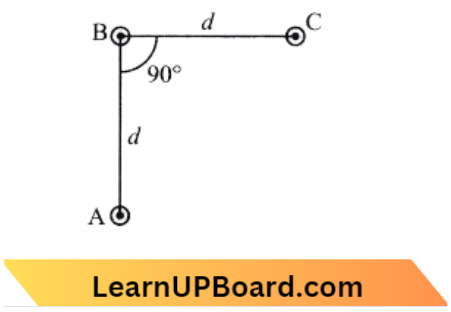
- \(\frac{\mu_0 I^2}{2 \pi d}\)
- \(\frac{2 \mu_0 I^2}{\pi d}\)
- \(\frac{\sqrt{2} \mu_0 I^2}{\pi d}\)
- \(\frac{\mu_0 I^2}{\sqrt{2} \pi d}\)
Answer: 4. \(\frac{\mu_0 I^2}{\sqrt{2} \pi d}\)
The force between BC and AC will be the same in magnitude,
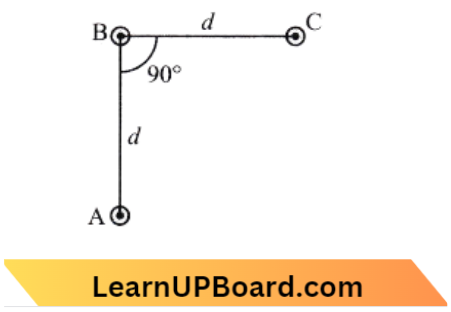
⇒ \(F_{B C}=F_{B A}=\frac{\mu_0 I^2}{2 \pi d}\)
and Resultant force on B,
F=\(\sqrt{F_1^2+F_2^2}\)
F=\(\sqrt{2} F_{B C}=\sqrt{2} \frac{\mu_0 I^2}{2 \pi d}\)
F=\(\frac{\mu_0 I^2}{\sqrt{2} \pi d}\)
Question 49. A square loop ABCD carrying a current I, is placed near and coplanar with a straight conductor XY carrying a current I, the net force on the loop will be:
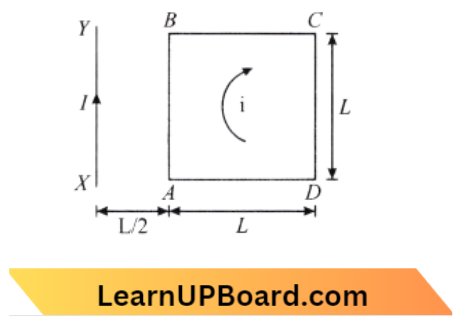
- \(\frac{\mu_0 I i}{2 \pi}\)
- \(\frac{2 \mu_0 I i \mathrm{~L}}{3 \pi}\)
- \(\frac{\mu_0 I i \mathrm{~L}}{2 \pi}\)
- \(\frac{2 \mu_0 I i}{3 \pi}\)
Answer: 4. \(\frac{2 \mu_0 I i}{3 \pi}\)
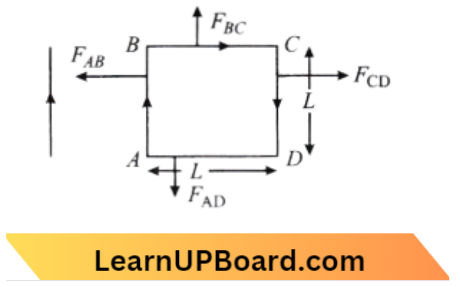
⇒ \(F_{A B}=I l B\) (attraction)
⇒ \(F_{A B}=\frac{\mu_0 l i(L)}{2 \pi(L / 2)}=\frac{\mu_0 l i}{\pi}\)
⇒ \(F_{B C}=(\uparrow) and F_{A D}(\downarrow)\)
Cancels each other, \(F_{C D}=I l B\) (Repulsion)
⇒ \(\mathrm{F}_{\mathrm{CD}} =\frac{\mu_0 I i(L)}{2 \pi(3 L / 2)}=\frac{\mu_0 l i}{3 \pi}\)
∴ \(F_{\text {net }} =\frac{\mu_0 I i}{\pi}\left(1-\frac{1}{3}\right)=\frac{2 \mu_0 l i}{3 \pi}\)
Question 50. A square loop carrying a steady I is placed in a horizontal plane near a long straight conductor carrying a steady current I1 at a distance cl from the conductor as shown in the figure, the loop will experience:
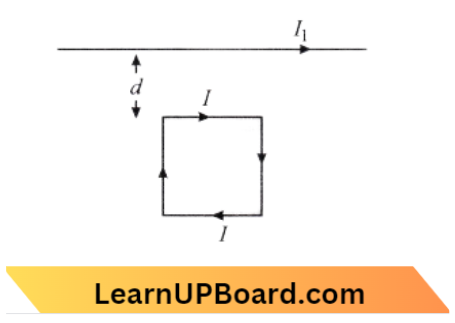
- a net repulsive force away from the conductor
- a net torque acting upward perpendicular to the horizontal plane
- a net torque acting downward normal to the horizontal plane
- a net attractive force toward the conductor
Answer: 4. a net attractive force toward the conductor
The situation is shown in the diagram,
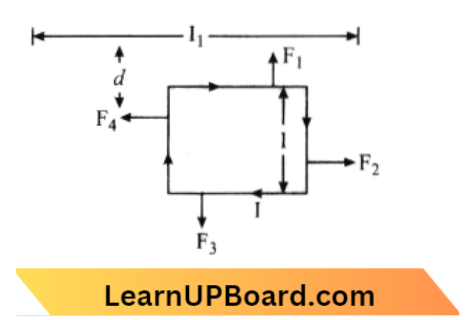
The relation between\( F_2\) and\( F_4\) is,
⇒ \(F_2 =-F_4\)
⇒ \(F_1 =\frac{\mu_0 \mathrm{I}_1 l}{2 \pi d}\)
⇒ \(F_2 =\frac{\mu_0 \mathrm{I}_1 l}{2 \pi(d+1)}\)
⇒ \(F_1 >F_3\)
⇒ \(F_net =F_1-F_3\)
So the wire attracts a loop.
Question 51. A long solenoid carrying a current produces a magnetic field B along its axis. If the current is doubled and the number of turns per cm is halved, the new value of the magnetic field is:
- \(\frac{B}{2}\)
- B
- 2 B
- 4 B
Answer: 2. B
Magnetic field induction at point insides the solenoid of length l, having n turns per unit length carrying current i. is given by B=\(\mu_0 n I\)
If 1 is double and n is halved then B remains the same.
Question 52. A uniform conducting wire of length 12a and resistance ‘R’ is wound up as a current-carrying coil in the shape of:
(1) an equilateral triangle of side ‘a’
(2) a square of side ‘a’
The magnetic dipole moments of the coil in each case respectively are:
- \(\sqrt{3} \mathrm{I} a^2\) and 3 \(\mathrm{I}^2\)
- 3\( \mathrm{I} a^2\) and \(\mathrm{I} a^2\)
- 3 \(\mathrm{I} a^2\) and 4 \(\mathrm{I} a^2\)
- 4 \(\mathrm{I}^2\) and 3 \(\mathrm{I} a^2\)
Answer: 1. \(\sqrt{3} \mathrm{I} a^2\) and 3 \(\mathrm{I}^2\)
Given the length of wire l=12 a
Resistance =\(\mathrm{R} \)
Current =\(\mathrm{I}\)
(1) Equilateral triangle of side a
m= ?
(2) Square of side ‘as we know, m=\(\mathrm{NI} A\)
Triangle, \(\mathrm{A}=\frac{\sqrt{3}}{4} a^2\)
Perimeter =3 \(\mathrm{a}\)
⇒ \(\mathrm{N}\) =4
m =4. I.\(\frac{\sqrt{3}}{4} a^2 \)
= \(\sqrt{3} \mathrm{I} a^2\)
Square \(\mathrm{A} =a^2\)
Perimeter =4 \(\mathrm{a} \)
⇒ \(\mathrm{N}\) =3
m= 3 \(\mathrm{I} a^2 \)
∴ \(\sqrt{3} I a^2, 3 I a^2\)
Question 53. A wire of length L carrying a current of I ampere is bent in the form of a circle. Its magnetic moment is:
- \(\frac{\mathrm{IL}^2}{4}\)
- \(\frac{\mathrm{I} \pi \mathrm{L}^2}{4}\)
- \(\frac{2 \mathrm{IL}^2}{\pi}\)
- \(\frac{\mathrm{IL}^2}{4 \pi}\)
Answer: 4. \(\frac{\mathrm{IL}^2}{4 \pi}\)
When a wire of length L is bent in the form of a circle of radius \(R_1\) then,
L=\(2 \pi R\)
R=\(\frac{L}{2 \pi} \)
Magnetic moment, \(\mu=1 \mathrm{~A}\)
= I\(\left(\pi R^2\right) \)
= I \(\cdot \pi \cdot\left(\frac{L}{2 \pi}\right)^2\)
= \(\frac{I \pi L^2}{4 \pi^2}=\frac{I L^2}{4 \pi}\)
Question 54. A 250-turn rectangular coil of length 2.1 cm and width 1.25 cm carries a current of 85 μA and is subjected to a magnetic field of strength 0.85T. Work done for rotating the coil by 180° against the torque is:
- 9.5 μ
- 4.55 μ
- 2.3 μ
- 1.5μ
Answer: 1. 9.5 μ
Work done for rotating the coil
W =M B\(\left(\cos \theta_1-\cos \theta_2\right)\)
W =M B\(\left(\cos 0^{\circ}-\cos 180^{\circ}\right)\)
= 2 M B=\(2 \times N I A \times B \)
= 2 \(\times 250 \times 85 \times 10^{-6} \times 2.1\)
= 9.48 \(\times 10^{-6} \mathrm{~J}\)
= 9.5 \(\mu \mathrm{J}\)
Question 55. A rectangular coil of length 0.12 m and width 0.1 m having 50 turns of wire is suspended vertically in a uniform magnetic field of strength 0.2 Wb/m². The coil carries a current of 2 A. If the plane of the coil is. inclined at an angle of 30° with the direction of the field, the torque required to keep the coil in stable equilibrium will be:
- 0.15 Nm
- 0.20 Nm
- 0.24 Nm
- 0.12 Nm
Answer: 2. 0.20 Nm
Given
A rectangular coil of length 0.12 m and width 0.1 m having 50 turns of wire is suspended vertically in a uniform magnetic field of strength 0.2 Wb/m². The coil carries a current of 2 A. If the plane of the coil is. inclined at an angle of 30° with the direction of the field
According to the question,

Magnetic field strength, B=0.2 \(\mathrm{~Wb} / \mathrm{m}^2\)
Number of turns, N=50, \(\theta=60^{\circ}\)
A=0.12\( \times 0.1=0.012 \mathrm{~m}^2\)
Then Torque, \(\tau =N l A B \sin \theta\)
= 50 \(\times 2 \times 0.012 \times 0.2 \times \sin 60^{\circ} \)
= 50 \(\times 2 \times 0.12 \times 0.2 \times \frac{\sqrt{3}}{2} \)
= 0.20 \(\mathrm{Nm}\)
Question 56. A current loop in a magnetic field:
- experiences a torque whether the field is uniform or non-uniform in all orientation
- can be in equilibrium in one orientation
- can be equilibrium in two orientations
- can be in equilibrium in two orientations are stable while the other is unstable
Answer: 4. can be in equilibrium in two orientations are stable while the other is unstable
For parallel is stable and for antiparallel is unstable.
Question 57. A circular Coil ABCD carrying a current i is placed in a uniform magnetic field, if the magnetic force on the segment AB is \(\vec{F}\), the force on the remaining segment BCDA is:
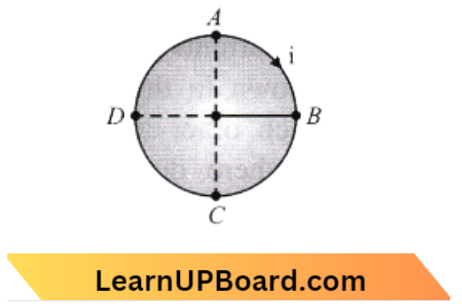
- \(-\vec{F}\)
- 3 \(\vec{F}\)
- \(-3 \vec{F}\)
- \(\vec{F}\)
Answer: 1. \(-\vec{F}\)
The net magnetic force on a current loop in a uniform magnetic field is always zero.

⇒ \({\mathrm{F}}_{\mathrm{AB}}+\overrightarrow{\mathrm{F}}_{\mathrm{BCAD}}\) =0
∴ \(\overrightarrow{\mathrm{F}}_{\mathrm{BCAD}}+-\overrightarrow{\mathrm{F}}_{\mathrm{AB}} =-\overrightarrow{\mathrm{F}}\)
Question 58. A square current-carrying loop is suspended in a uniform magnetic field acting in the plane of the loop. If the force on one arm of the loop is \(\vec{F}\) :
- \(3 \vec{F}\)
- –\(\vec{F}\)
- –\(\overrightarrow{3 F}\)
- \(\vec{F}\)
Answer: 2. –\(\vec{F}\)
If magnetic field B is uniform then force on closed path = 0
One force is l7 then we want to give the total force as zero.
This confirms that, \(\vec{F}=-\vec{F}\) for zero net force
Question 59. A closely wound solenoid of 2000 turns and area of cross-section 1.5 x \(10^{-4} \mathrm{~m}^2\) carries a current of 2.0 A. It is suspended through its center and perpendicular to its length, allowing it to turn in a horizontal plane in a uniform magnetic field \(5 \times 10^{-2}\) T making an angle of 30° with the axis of the solenoid, the torque on the solenoid will be:
- \(3 \times 10^{-3} \mathrm{~N}-\mathrm{m}\)
- 1.5 \(\times 10^{-3} \mathrm{~N}-\mathrm{m}\)
- 1.5 \(\times 10^{-2} \mathrm{~N}-\mathrm{m}\)
- 3 \(\times 10^{-2} \mathrm{~N}-\mathrm{m}\)
Answer: 3. 1.5 \(\times 10^{-2} \mathrm{~N}-\mathrm{m}\)
Given
A closely wound solenoid of 2000 turns and area of cross-section 1.5 x \(10^{-4} \mathrm{~m}^2\) carries a current of 2.0 A. It is suspended through its center and perpendicular to its length, allowing it to turn in a horizontal plane in a uniform magnetic field \(5 \times 10^{-2}\) T making an angle of 30° with the axis of the solenoid
From the question, N=2000 \(\mathrm{~A}, A=1.5 \times 10^{-4} \mathrm{~m}^2\)
I=2 \(\mathrm{~A}, B=5 \times 10^{-2} \mathrm{~T}, \theta=30^{\circ} \)
Torque, \(\tau =N I B A \sin \theta\)
=2000 \(\times 2 \times 5 \times 10^{-2} \times 1.5 \times 10^{-4} \times \sin 30^{\circ}\)
=2000 \(\times 50 \times 10^{-6} \times \frac{1}{2}\)
=1.5 \(\times 10^{-2} \mathrm{Nm}\)
Question 60. A closed-loop PQRS carrying a current is placed in a uniform magnetic field. If the magnetic forces on segments PS, SR, and RQ are \(F_1, F_2\) and \(F_3\) respectively, and are in the plane of the paper and along the directions shown, the force on the segment QP is:
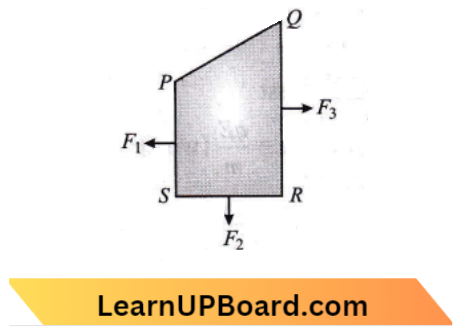
- \(F_3-F_1-F_2\)
- \(\sqrt{\left(F_3-F_1\right)^2+F_2^2}\)
- \(\sqrt{\left(F_3-F_1\right)^2-F_2^2}\)
- \(F_3-F_1+F_2\)
Answer: 2. \(\sqrt{\left(F_3-F_1\right)^2+F_2^2}\)
The total force on the current carrying closed loop should be zero. If placed in a uniform magnetic field.
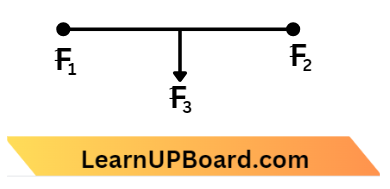
⇒ \(F_{\text {horizontal }} =F_3-F_1\)
⇒ \(\mathrm{~F}_{\text {vertical }} =F_2\)
Resultant of \(\vec{F}_1, \vec{F}_2 and \vec{F}_3 is \vec{F},\)
Where, \(\vec{F}=\sqrt{\left(F_3-F_1\right)^2+F_2^2}\)
since total force =0,
Hence force on QP is equal to \(\vec{F}\) in magnitude but opposite direction
∴ \(F_{\mathrm{QP}}=\sqrt{\left(F_3-F_1\right)^2+F_2^2}\)
Question 61. A charged particle (charge q) is moving in a circle of radius R with uniform speed v. The associated magnetic moment p is given by:
- \(q v R^2\)
- \(q v R^2 / 2\)
- qvR
- qvR / 2.
Answer: 4. \(q v R^2\)
Magnetic moment \(\mu\)=I A
Since, T=\(\frac{2 \pi R}{v}\)
also, I=\(\frac{q}{T}=\frac{q v}{2 \pi R}\)
⇒ \(\mu =\left(\frac{q v}{2 \pi R}\right)\left(\pi R^2\right)\)
= \(\frac{q v R}{2}\)
Question 62. A current-carrying coil is subjected to a uniform magnetic field. The coil will orient so that its plane becomes:
- inclined at 45° to the magnetic field
- inclined at any arbitrary angle to the magnetic field
- parallel to the magnetic field
- perpendicular to the magnetic field
Answer: 3. parallel to the magnetic field
The coil must be oriented in such a way that its magnetic moment coincides with the field. so that the coil’s magnetic force is zero.
Question 63. The current sensitivity of a moving coil galvanometer is 5 div/mA and its voltage sensitivity (angular deflection per unit voltage applied) is 20 div/V. The resistance of the galvanometer is:
- 250 Ω
- 25 Ω
- 40 Ω
- 500 Ω
Answer: 1. 250 Ω
Current sensitivity \(\left(\mathrm{I}_{\mathrm{S}}\right)\) for moving coil galvanometer is:
⇒ \(I_S=\frac{\theta}{I}=\frac{N A B}{C}\) → Equation 1
Where, N = Number of turns in the coil
A = Area of each turn of the coil
B = Magnetic field
C = Restoring torque per unit twist of the stip
Again, voltage sensitivity \((V_S)\) is given by,
⇒ \(V_S =\frac{\theta}{V}=\frac{N A B}{C R_G}\) → Equation 2
⇒ \(R_G\) = resistance of galvanometer
Resistance of galvanometer is, \(R_G=\frac{I_S}{V_s}=\frac{5 \times 1}{20 \times 10^{-3}}=\frac{5000}{20}=250 \Omega\)
∴ \(R_G=250 \Omega\)
Question 64. In the ammeter, 0.2% of the main current passes through the galvanometer. If the resistance of the galvanometer is G, the resistance of the ammeter will be:
- \(\frac{1}{499}\) G
- \(\frac{499}{500}\) G
- \(\frac{1}{500}\) G
- \(\frac{500}{499}\) G
Answer: 1. \(\frac{1}{499}\) G
The situation of the question is given below,

For ammeter, \(\mathrm{G} \times 0.002 l =0.998 l \times r_g\)
∴ –\(\ r_g =\frac{0.002}{0.998} \mathrm{G}=\frac{1}{499} \mathrm{G}\)
Question 65. A millivoltmeter of 25 mV range is to be converted into an ammeter of 25 A range. The value (in ohm) of the necessary shunt will be:
- 0.001
- 0.01
- 1
- 0.05
Answer: 1. 0.001
Deflection current \(\mathrm{I}_g=\frac{25 m v}{G} ampere\)
Where, \(\mathrm{G}\)= resistance of meter
The value of the shunt will be,
S= \(\frac{I_g G}{I-I_g}=\frac{25 M V}{25}=0.001 \Omega\)
Question 66. A galvanometer of resistance, G is shunted by a resistance S ohm. To keep the main current in the circuit unchanged, the resistance to be put in series with the galvanometer is:
- \(\frac{S^2}{(S+G)}\)
- \(\frac{S G}{(S+G)}\)
- \(\frac{G^2}{(\mathrm{~S}+G)}\)
- \(\frac{G}{(S+G)}\)
Answer: 3. \(\frac{G^2}{(\mathrm{~S}+G)}\)
According to the question,
If resistance is the same then the current is unchanged
G = \(\frac{G S}{G+S}+R \)
R = \(G-\frac{G-S}{G+S}\)
= \(\frac{G^2}{G+S}\)
Question 67. A galvanometer has a coil of resistance 100 Ω and gives a full-scale deflection for 30 mA current. If it is to work as a voltmeter in the 30 V range, the resistance required to be added will be:
- 900 Ω
- 1800 Ω
- 500 Ω
- 1000 Q
Answer: 1. 900 Ω
Required resistance, R =\(\frac{V}{i_g}-G=900 \mathrm{~W}\)
=\(\frac{30}{30 \times 10^{-3}}-100=900 \Omega\)
Question 68. A galvanometer having a coil resistance of 60 Ω shows full-scale deflection when a current of 1.0 A passes through it. It can be converted into an ammeter to read currents up to 5.0 A by:
- putting in parallel a resistance of 240 Ω
- putting in series a resistance of 15 Ω
- putting in series a resistance of 240 Ω
- putting in parallel a resistance of 15 Ω
Answer: 4. putting in parallel a resistance of 15 Ω
From the question,
Given, \(G_1=60 \Omega, \mathrm{I}_{\mathrm{g}}=1.0 \mathrm{~A}, \mathrm{I}=5 \mathrm{~A}\)
⇒ \(\mathrm{I}_{\mathrm{g}} G=\left(I-I_{\mathrm{g}}\right) S\)
S=\(\frac{I_g G}{I-I_{\mathrm{g}}}=\frac{1}{5-1} \times 60=15 \Omega\)
Question 69. A galvanometer of resistance 50 Ω connected to a battery of 3 V along with a resistance of 2950 Ω. in series. A full-scale deflection of 30 divisions is obtained in the galvanometer. To reduce this deflection is 20 divisions order to reduce this deflection to 20 divisions, the resistance series should be:
- 5050 Ω
- 5550 Ω
- 6050 Ω
- 4450 Ω
Answer: 4. 4450 Ω
Given
A galvanometer of resistance 50 Ω connected to a battery of 3 V along with a resistance of 2950 Ω. in series. A full-scale deflection of 30 divisions is obtained in the galvanometer. To reduce this deflection is 20 divisions order to reduce this deflection to 20 divisions
Current through a galvanometer,
I=\(\frac{3 V}{50 \Omega+2950 \Omega}=10^{-3} \mathrm{~A}\)
Current for 30 division =\(10^{-3} \mathrm{~A}\)
= \(\frac{20}{30} \times 10^{-3}\)
= \(\frac{2}{3} \times 10^{-3} \mathrm{~A}\)
= \(\frac{3}{50+R}\)
R=4450 \(\Omega\)
Question 70. The resistance of an ammeter is 13 Ω and its scale is graduated for a current up to 100 amps. After an additional shunt has been connected to this ammeter it becomes possible to measure currents up to 750 amperes by this meter. The value of shunt-resistance is:
- 2 Ω
- 0.2 Ω
- 2 k Ω
- 20 Ω
Answer: 1. 2 Ω
Let S= shunt resistance
Given that, I=750 \(\mathrm{~A}\)
⇒ \(I_g=100 \mathrm{~A}, R_G=13 \Omega\)
from the figure, \(I_g R_G =\left(I-I_g\right) S \)
100 \(\times 13 =[750-100] S\)
S =2 \(\Omega\)
Question 71. A galvanometer acting as a voltmeter will have:
- a high resistance in parallel with its coil
- a high resistance in series with its coil
- low resistance in parallel with its coil
- a coil resistance in series with its coil
Answer: 2. a high resistance in series with its coil
A galvanometer acting as a voltmeter will have a high resistance in series with its coil.
Question 72. A galvanometer of 50 ohm resistance has 25 divisions. A current 4 x 10-4 ampere gives a deflection of one division. To convert this galvanometer into a voltmeter having a range of 25 volts, it should be connected with a resistance of:
- 2500 Ω as a shunt
- 2450 Ω as a shunt
- 2550 Ω in series
- 2450 Ω in series
Answer: 4. 2450 Ω in series
Given
A galvanometer of 50 ohm resistance has 25 divisions. A current 4 x 10-4 ampere gives a deflection of one division. To convert this galvanometer into a voltmeter having a range of 25 volts,
Total current in the galvanometer,
⇒ \(I_g=25 \times 4 \times 10^{-4} \mathrm{~A}\)
⇒ \(I_g=10^{-2} \mathrm{~A}\)
The value of resistance connected in series to convert a galvanometer into a voltmeter of 25 \(\mathrm{~V}\) is
R =\(\frac{V}{I_g}-G \)
= \(\frac{25}{10^{-2}}-50 \)
= 2450 \(\Omega\)
Question 73. To convert a galvanometer into a voltmeter one should connect a:
- high resistance in series with the galvanometer
- low resistance in series with the galvanometer
- high resistance in parallel with the galvanometer
- low resistance in parallel with the galvanometer
Answer: 1. High resistance in series with the galvanometer
To convert a galvanometer into a voltmeter one should connect a high resistance in series with galvanometer.

